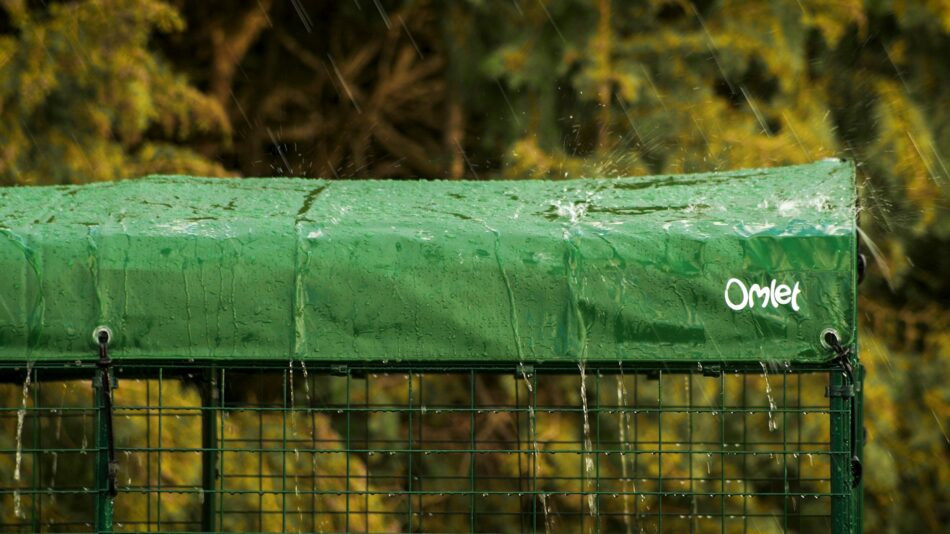
June 1st marks the beginning of hurricane season in the US. If you live along the coast, you’re probably familiar with these hurricane preparation steps: putting fresh batteries in flashlights, stocking up on non-perishable food items, making sure your car’s gas tank is full, filling water jugs and bottles, and maybe even investing in a generator. But are you preparing your chickens for hurricane season?
It’s important to have a plan if and when a hurricane strikes. This includes planning for your family, indoor pets, and outdoor pets. Thankfully, there are easy steps that you can take to make sure your chicken weather hurricane season along with you.
4 Hazards of hurricanes to chickens
Hurricanes bring a whole host of severe weather conditions – many of which can be very hazardous to your hens. Electrical outages, water shortages, and decreased mobility all add to the difficult situations that come along with hurricanes. Get ahead of the storm and prepare your chickens for hunkering down during a hurricane.
1. Supply shortages and hazardous driving conditions
Stock up on your flock’s feed well before the storm is anticipated to make landfall. Suppliers may not be able to make deliveries to stores as the storm grows stronger, so keeping an extra bag or two of feed at the beginning of hurricane season is a wise investment. You may also want to keep reserves of bedding in your supplies so that you don’t have to brave the roads in search of shavings or straw. Keep empty drink containers to refill with drinking water for your hens, or purchase containers to store water in.
2. High winds
Wind gusts of over 75 mph are common during hurricanes and tropical storms, and in the case of category 3 hurricanes and higher, can reach speeds of over 100 mph. If a hurricane does not warrant evacuation, your hens should be firmly secured inside of a strong chicken coop. Tethering your hens’ house to the ground through the use of ground rods such as t-posts and tie-down straps will help prevent movement during high winds.
3. Heavy rainfall and flooding
Make sure your chickens have an elevated chicken coop to escape to during heavy rainfall. It’s common for hurricanes to cause flooding – sometimes in the form of flash floods. Giving your hens plenty of chicken perches inside of their run will give them a safe place to escape from rapidly rising water. Adding weather protection to your chickens’ run will help abate the accumulation of rainfall.
4. Tornadoes
Similar to high winds, tornadoes can topple chicken coops or even toss them around your yard. Tornadoes are common events during a hurricane or tropical storm and can form quickly. In addition to making sure your chicken coop is tethered to the ground to prevent it from being overturned, keep your chickens’ coop away from trees or powerlines that could potentially fall. Mobile chicken coops are particularly helpful for sudden weather events, as they can be moved to safety quickly on short notice.
Weatherproofing your chicken coop for a hurricane
Hurricanes typically come with advance warning, but you’ll need a plan to put into action once a hurricane warning has been issued. Many of these modifications can even be made at the start of hurricane season to avoid having to frantically prepare your flock when the weather turns wild.
Temporary chicken housing
If you have an old wooden chicken coop vs a sturdy plastic coop, relocating your chicken flock to a safer space may sometimes be the best option in preparation for a hurricane or tropical storm. A garage, shop, or sturdy shed can house hens that are displaced due to weather conditions. Be sure all hazardous materials are out of your flock’s reach, like:
- Electrical cords or wiring
- Pesticides, weed killer, antifreeze, motor oil, or other liquids
- Exposed lawn mower blades or other sharp lawn care instruments
Or, in an emergency, you may need to temporarily house your chickens in your home. An enclosed space that’s easy to clean like tiled rooms or areas are ideal temporary housing for chickens. A playpen designed for small animals can keep your hens contained to a desired area of your home.
Chicken tractors for easy relocation
Our chicken tractors are mobile chicken coops that are designed to be moved quickly and easily. For chicken keepers living in regions that frequently experience severe weather, mobile chicken coops offer the best flexibility for your flock. Simply engage the wheels on each side, then roll your hens’ entire home to safety. This could be in a garage or shed or another sturdy structure, to higher ground in the case of flooding, or simply out of the trajectory of trees or power lines that could potentially fall during a hurricane.
Fortifying stationary coops
The best option for flocks that will be staying put during a storm is the Eglu Cube Chicken Coop. Heavy-duty and waterproof, our largest chicken coop can keep your hens safe during perilous times. These strong chicken coops have withstood hurricanes, tornadoes, falling trees, and other wild weather events.
Fortify your flock’s Eglu Cube with an Automatic Chicken Coop Door by Omlet. The horizontal opening and closing mechanism operates on a spiral gear system, which makes it incredibly difficult to pry or force open. The audible seal, once the Autodoor has closed, lets you know that your hens are safe inside their reinforced coop.
If your coop and run will be staying put, add screw pegs along the bottom of the run to help hold it down during high winds. For excessive wind speeds, use tie-down straps to anchor your Eglu Cube to the ground. T-posts, fences set in concrete, or buildings with foundations make good anchor points for straps.
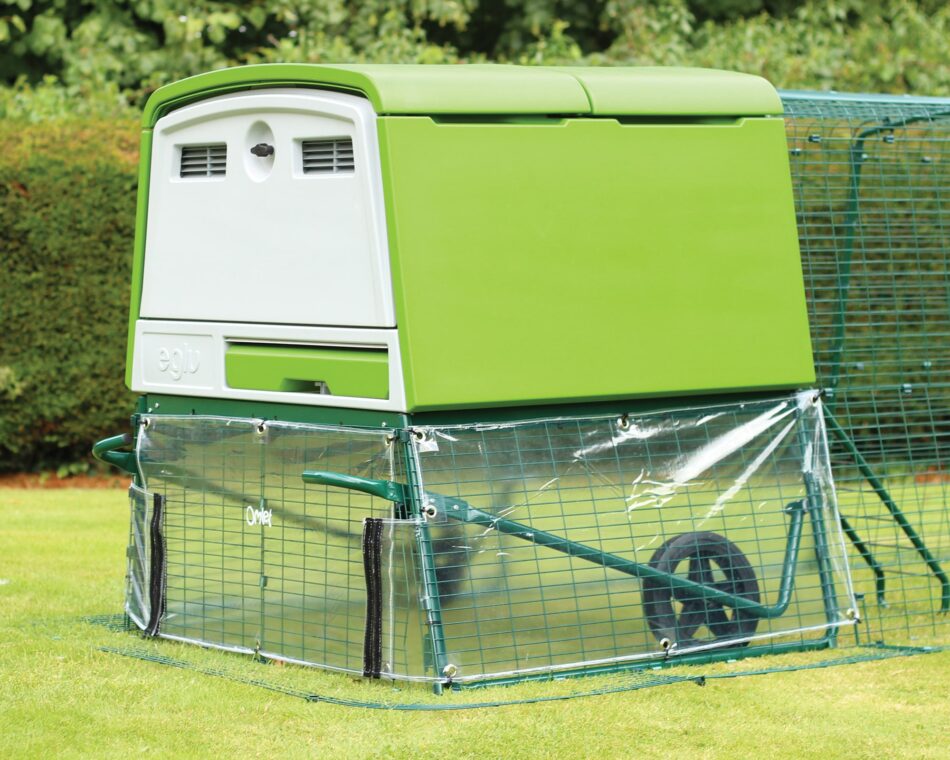
Evacuation planning
Sometimes it’s safer to evacuate in preparation for a strong hurricane. Evacuations can be voluntary or mandatory, but whatever the case may be, you’ll need to have a plan for your flock. A mobile chicken coop can be easily rolled onto a small trailer or truck to be relocated. Or, you can quickly disassemble your Omlet chicken coop to take with you. Your Eglu coop can then be easily reassembled once you reach your destination. Chicken fencing is also quick and easy to take down and reassemble to give your flock some space once you arrive.
Hens can be transported in dog kennels, but take care when using wire kennels, as your chickens’ legs may get caught. The best kennels to use are those with plastic floors and sides. Rabbit cages are also suitable for transporting hens.
5 hurricane essentials to bring with you:
- Feed and feeders
- Water and waterers
- Housing (either their regular coop, or temporary accommodations)
- Additional bedding for their coop
- Chicken supplements to help combat the stress of relocating
After the hurricane
After the storm has passed, it will be time to assess the damage. First, check in with your chickens if they weathered the storm in their coop to make sure none of them sustained injuries. Contact your veterinarian right away if you suspect any illness or injury resulting from the stress of the storm.
Carefully remove debris from your yard or anywhere that your chickens have access to. Broken glass or garden decor, metal, screws, nails, or any other sharp objects should be removed before letting your chickens back out. Check to make sure your chicken run is still securely anchored into the ground, and that all of the clips are still intact.
Offer your flock food and water as soon as they are let out of their coop. The sooner they can get back into their regular routine, the sooner they will unwind from recent events. A stressed-out chicken may not want to eat right after being let out of the coop, but check in with your hens to make sure they are back to eating and drinking within the next several hours. You may also notice a decrease in egg production in the days following a stressful event like a severe storm, which is completely normal.
Be extra vigilant after a severe storm, as wildlife can be displaced during the chaos. Chicken predators like foxes, coyotes, raccoons or stray dogs and cats may find themselves closer to your flock than before as a result of fleeing rising waters or high winds, and will be in search of an easy meal. Rodents will also be on the lookout for seeds and feed they can swipe, so pick up any leftover food from your flock for several days following a storm.
Omlet and chicken care
Omlet makes preparing your chickens for hurricane season less stressful. Give yourself peace of mind when you get your hens a strong, capable coop to help them weather the storms. Whether you ride out the storm at home, or evacuate to temporary accommodations, our expertly designed Eglu Cube and Autodoor will have your hens hunkering down safely during hurricanes.
This entry was posted in Chickens
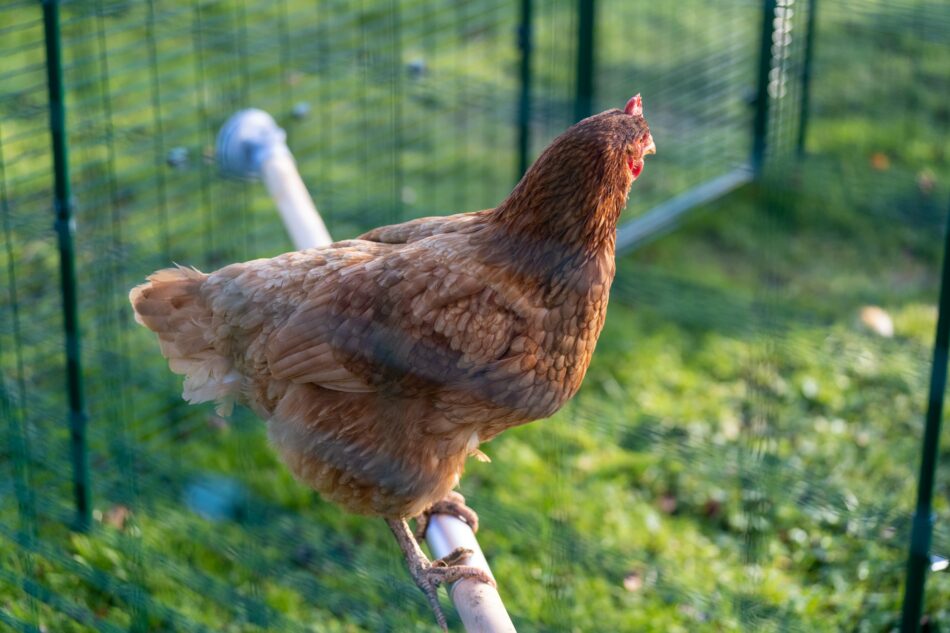
Backyard chickens have been rising in popularity over the past several years. Once viewed as farm animals, chickens are now gracing the backyard of many families living in suburban areas. If you’ve been curious about starting your own backyard flock of chickens, we’re here to equip you with knowledge and products to make keeping chickens a success.
4 reasons to keep backyard chickens
Keeping backyard chickens is a great hobby that can be shared with the entire family. The relationship between hens and humans is very symbiotic. Chickens are prey animals that need protection from predators, and when provided with care and shelter can thrive in virtually any setting. Hens offer humans companionship, backyard pest control, and of course – fresh eggs.
Having chickens in your backyard will:
- Provide your family with fresh eggs year-round
- Reduce stress through more screen-free time spent outdoors
- Be a unique pet experience for you and your family
- Teach the value of work and responsibility to children
Backyard chicken keepers enjoy watching their flock simply peck the ground and go about their daily routine. You’ll be amazed by how even a small flock of hens can decimate the population of pests like ants, spiders, snails, and even scorpions. All that added protein gets converted into delicious and nutritious eggs for you to collect from your chickens’ coop daily.
How to choose your backyard chicken coop
Backyard chicken coops are the most important component of owning hens. Your hens’ home will need to shelter them from the elements and predators, offer a safe place to lay their eggs, and keep them comfortable in all seasons. And as their caretaker, you’ll be spending time cleaning and maintaining your flock’s coop. Your choice of a chicken coop can be the difference between backyard chicken keeping being an either enjoyable hobby or a dreaded chore.
When choosing your chicken coop, determine:
- Whether a wooden or plastic chicken coop will suit you best
- Whether or not you need a mobile chicken coop
- How much space you have
- How much time you’d like to spend cleaning and maintaining your coop
- The amount of time you’d be willing to spend assembling a chicken coop
Find your perfect backyard coop with Omlet
Omlet chicken coops: what backyard chicken keepers’ dreams are made of. Truly incredible hen houses, our coops keep your flock healthy and happy, while cutting down on your workload. Omlet chicken coops:
- Can be converted into mobile chicken coops
- Feature twin-insulated walls to keep your hens warm in the winter and cool in the summer
- Have unique safety features like a pull-and-twist coop door opening mechanism and predator-resistant access door handles
- Are made from heavy-duty plastic that will never rot
- Take only a few minutes to clean thoroughly
The best chicken coops are those that bring joy to both flocks and their keepers. From our chicken tractors to our large chicken coops, there’s an Omlet coop for everyone to start enjoying raising backyard chickens.
What chicken run should I get for my flock?
Flocks forage and roam by nature, but having a backyard chicken run will not only help keep your hens close to home, but also away from potential danger. From plants toxic to chickens to neighborhood dogs and cats, containing your chickens in a run is the best way to keep them out of harm’s way.
When choosing a run for your chickens, aim to offer the most space possible. Omlet’s walk in chicken runs provide full protection from predators with roof panels and anti-dig skirting. Our runs can also be extended as your flock grows to give them plenty of room.
If a chicken run isn’t feasible for your space, chicken fencing is another option to contain your flock. Our flexible chicken fencing can be adjusted to any shape and can be attached to a wall or with repositionable posts. And, with easy-access gates, you can enter and tend to your flock.
Is it legal to keep hens in the backyard?
Laws vary between states regarding keeping backyard chickens, but most states leave the decision up to individual cities or homeowners associations (HOAs). Before you buy a backyard chicken coop and obtain hens, you’ll need to check with your city zoning office or HOA to get permission. Any laws about keeping chickens will likely be in regard to:
- The number of chickens you can keep
- Your backyard chicken coop location, size, or type
- Restrictions on owning roosters
Your chickens’ coop will most likely need to be kept a certain distance from your house or other homes. Ask if this restriction applies to your backyard, and keep the distances in mind even with mobile chicken coops.
The best backyard chicken breeds
The best backyard chicken breeds are those that are able to best tolerate your climate and lifestyle. Chicken breeds vary widely, and have tendencies such as temperament and behavior specific to their breed. Breeds to consider keeping in your backyard include:
Large breeds such as Brahmas or Jersey Giants can also make good choices in a backyard chicken flock as they are too heavy to fly long distances and are resilient in most climates.
Once you’ve decided on the breeds you’re interested in keeping, you’ll need to see where you can find your chickens. You can find a local breeder to help you obtain your chicks or hens. Chicks can also be obtained from most feed stores in the spring and summer months.
Tips for caring for & protecting your new flock
Keeping backyard chickens healthy and happy can be accomplished by caring for your hens on a daily basis, and providing them with protection, entertainment, and enrichment. The care that your backyard chickens will need includes:
- Feeding them a high-quality layer pellet diet
- Keeping fresh water available at all times
- Cleaning their coop thoroughly several times a week
- Protection from predators
It’s also good to offer opportunities for your hens to entertain themselves in an enriching way. Our line of chicken toys and accessories will ensure that your flock is never bored. Encouraging your flock to be active is particularly important during the colder months.
Seasonal changes are easy to prepare for with Omlet. Our chicken weather protection offers shade from the sun, shelter from wind, rain, and snow, and helps prevent hazardous living conditions for your backyard chickens. In sub-freezing weather, extreme temperature jackets for chicken coops can be added to your hens’ home for additional insulation.
How Omlet backyard coops defend against predators
Omlet’s chicken runs all come standard with anti-dig skirting to help prevent predators that aim to tunnel into the run. Our Eglu Cube chicken coop features t-lock handles on the exterior coop access doors and smaller mesh spacing along the bottom panels of the attached run to prevent reach from predators such as raccoons. Other chicken predators we’ve designed our coops to thwart include:
- Foxes
- Coyotes
- Hawks
- Snakes
- Raccoons
- Neighborhood cats or dogs
Installing an automatic chicken coop door adds an additional layer of security to your coop. The horizontal opening and closing mechanism is extremely difficult for prying paws to open. Securing your hens in their backyard chicken coop each night will bring them a better night’s rest – peace of mind for you.
What to avoid when backyard chicken keeping
Some additional thoughts to keep in mind:
- Never leave free-roaming hens unsupervised
- Don’t forget to find a chicken sitter if you’ll be away from home for more than a day or two
- Slowly introduce other pets like dogs or cats to your hens to prevent startling or injuring them
- Select a vet that treats poultry ahead of time in the event of illness or emergencies
Above all, don’t take the plunge into poultry before you’ve assembled your chickens’ coop and run and become familiar with using them. Omlet’s chicken coops and runs come with everything you need to safely keep chickens as soon as our products have been assembled – so be sure to follow our step-by-step instructions to completion before obtaining your hens.
Backyard chicken keeping with Omlet
Raising backyard chickens is a rewarding journey – start strong with products that will last a lifetime. Our chicken coops protect thousands of flocks in backyards all over the world. Customize your yard or chicken run with unique products like the Chicken Swing and PoleTree Customizable Chicken Perch for a truly one-of-a-kind experience. At Omlet, we’ve created the best products to make keeping chickens in your backyard not only a reality but a success.
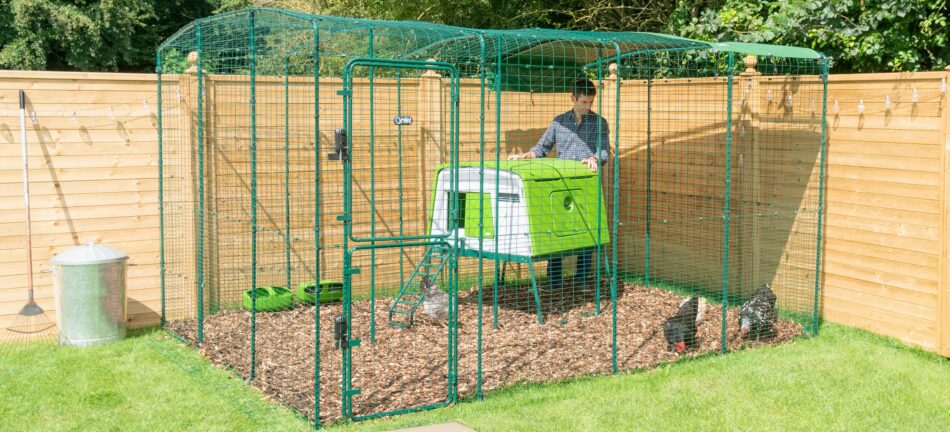
This entry was posted in Chickens
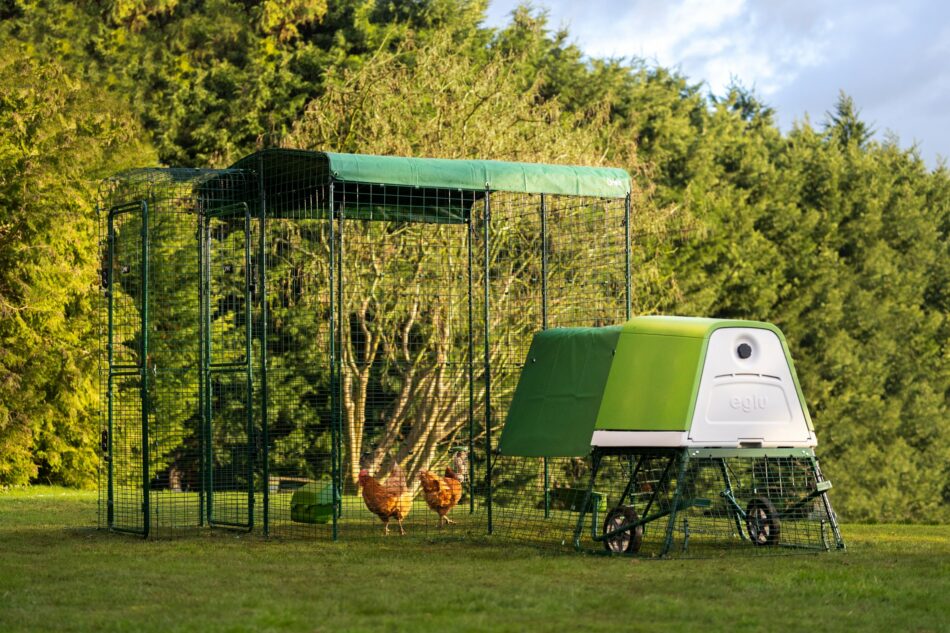
Looking for a beginner chicken coop? The best chicken coop for beginners are those that can grow along with flocks and their keepers – making it the first and last chicken coop you’ll need to buy. There’s a lot hinging on your hens’ home: their health, safety, and comfort. You’ll also want a coop that is easy and quick for you to clean, and is enjoyable to use. Omlet has the coops to check all of those boxes – and more.
The best Omlet chicken coops for beginners
The best chicken coops grow with their flocks and keepers’ level of experience. And, the best beginner chicken coops are easy to use from the start, but also functional and practical enough for even the most advanced chicken keeper.
We’ve made keeping chickens easy for all ages and stages of flock-raisers. Omlet’s line of Eglu chicken coops not only provide superior safety and comfort to the hens they house, but also allow owners to spend less time cleaning and worrying and more time enjoying their flock.
All of our coops are:
- Easy to build
- Simple to clean
- Predator resistant
- Have the ability to be mobile with the addition of our wheels and handles kit
- Are twin-wall insulated, keeping your flock comfortable all year round
Choosing your chicken coop depends on your space and how big of a flock you intend to keep. Once you’ve got an idea of where you want to place your coop and how many hens you want to have, you’re ready to find the coop that best fits your needs.
Types of chicken coops
There are a few choices to make when it comes to buying a beginner chicken coop. Some popular options are:
Each type of chicken coop has their own advantages, so you’ll need to decide which option best fits your lifestyle and space. For example, mobile chicken coops allow you to move your flock around your yard whenever you’d like. This lets your hens peck new grass and prevents a permanent spot from being worn into your lawn. Large chicken coops can house up to 10 small breed hens comfortably, and can also be converted into chicken tractors. Ground-level coops are best for chickens that don’t have a strong roosting drive, or for yards subject to height restrictions.
Wood vs plastic chicken coops
Above all, the best chicken coop for beginners is a plastic chicken coop. There are many reasons why plastic chicken coops are better than wooden chicken coops, as plastic is:
- Easier to clean
- Mite-resistant
- Rot-proof
- Better insulated
- Draft-free
- Easier to assemble
Purchase a plastic chicken coop at the beginning of your chicken-keeping journey, and it will serve you and your flock for years to come.
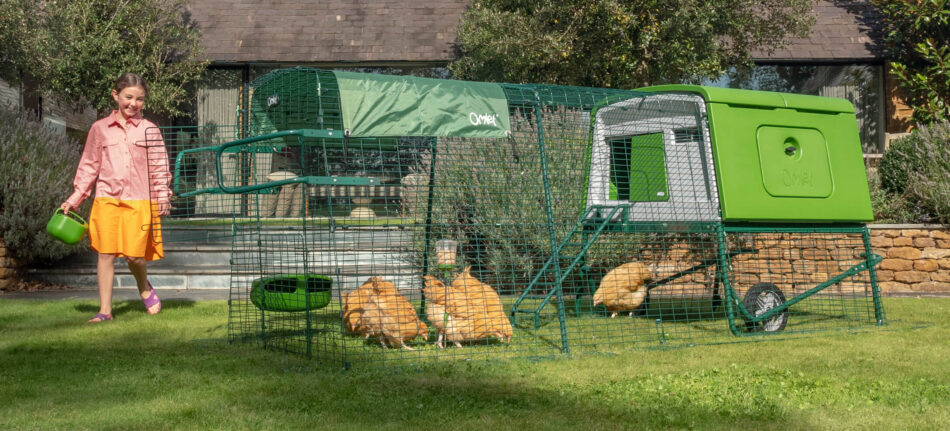
DIY vs ready-made chicken coops
Deciding whether to buy or build your first chicken coop? Building a proper chicken coop from scratch is hard – especially if you’re new to chickens. Hens have essentials when it comes to their home, and it’s hard for DIY plans to get them right. Most DIY plans look aesthetically pleasing, but leave much to be desired in functionality, safety, and practicality.
Omlet coops come as a kit to be assembled and have everything you need to get started with your flock right away. Our designs have been keeping hens healthy and happy for over a decade – so there’s no guesswork for you.
Choosing the perfect size coop for your flock
There’s a term that all chicken keepers will experience at some point: chicken math.
It’s used to describe the phenomenon of bringing home more chickens than you originally intended. This can occur right off the bat, or take a few months to set in, but at some point, most (if not all) chicken keepers crave more chickens.
That being said, it’s always best to get the biggest coop you can for your space and budget. Chickens thrive when as much space as possible is available to them, and extra space allows room for the inevitable chicken math conundrum.
What needs to be in your new chicken coop
A good chicken coop keeps hens comfortable, safe, and shielded from the elements – but a great chicken coop offers entertainment and enrichment as well. Chickens get bored if they don’t have enough stimulation, which can lead to behavioral and health issues. Be sure to offer a variety of things to keep your flock busy when they’re in their coop’s attached run. To bust boredom, try offering:
The more space and activities your hens have, the happier and healthier they’ll be. Some other ideas to keep boredom at bay include: serving fresh veggies in a Caddi Chicken Treat Holder, socializing with your flock, or moving a mobile chicken coop to fresh pecking grounds.
Top chicken coop care tips for new keepers
New chicken keepers should keep the following in mind when taking care of their chicken coops:
- Clean out your chickens’ coop daily to keep it fresh and to keep your hens’ in good health
- Use an odor-absorbing bedding such as pine pellets or shavings
- At least once a week, remove the roosting rack and droppings tray from your coop to pressure wash, or scrub with soap and water
- Collect eggs daily to help prevent broody hens and visits from predators
Keeping your chicken coop clean is one of the best ways to ensure that your hens are in a healthy atmosphere. Like most birds, chickens keep themselves clean through preening and dust bathing – but it’s up to their owners to keep up with their housekeeping.
Choosing a run your flock will love
Companion pieces to most chicken coops are chicken runs. Even if you want your hens to have access to most of your yard, there will inevitably be times that you’ll want to keep them penned up in a run. Large chicken runs give flocks that free-range feeling, without the hazards.
The best option for large spaces is a walk in chicken run. Not only does it maximize your chickens’ space, but it allows you to walk with your flock and get closer than ever to your hens. Omlet’s walk in chicken runs can also be extended at any time to accommodate a growing flock. Covers for walk in chicken runs can be added to give your flock shade from the sun or a barrier from snow, rain, and wind.
Other considerations when choosing your coop
Once you’ve researched and chosen the type of coop that best fits your lifestyle, you’ll also need to consider: chicken predators, the changing seasons, and zoning laws that may be applicable to you.
Predators
Omlet coops are designed to protect against chicken predators. The types of predators vary depending on your location, and you can bet that at some point they will come after your hens. Common chicken predators include:
- Raccoons
- Hawks
- Coyotes
- Foxes
- Snakes
- Neighborhood cats and dogs
Adding an automatic chicken coop door to your chickens’ coop adds an extra layer of protection against predators. The Autodoor ensures that your flock is safely closed into their coop each night, and the horizontal opening mechanism makes it extremely difficult for predators to pry open.
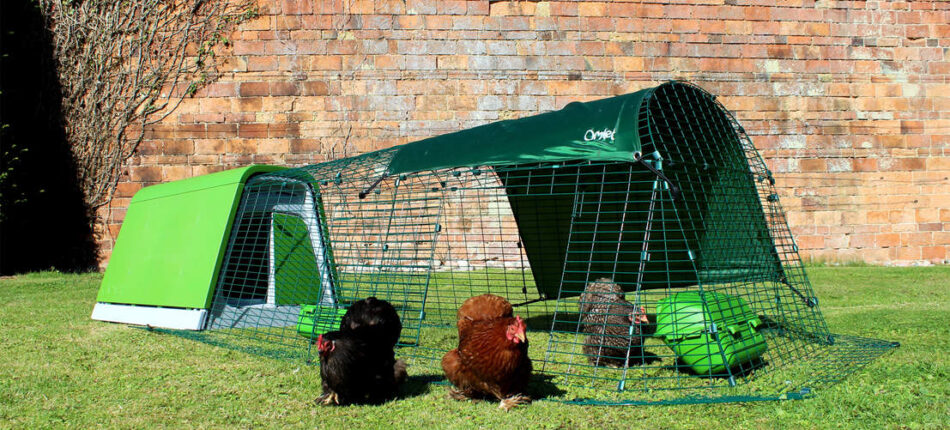
Seasons
Chickens are amazingly resilient, being built for life outdoors. However, not all breeds fare well in extreme temperatures. That’s why it’s so important to choose breeds that are suited to your location’s climate. Cold hardy breeds typically don’t fare well in the heat, while heat-tolerant breeds may struggle in the bitter cold. Aging hens may also not weather the changing seasons as they once did, and some minor coop modifications can go a long way in helping them through the extreme temperatures.
For areas that experience prolonged sub-freezing temperatures, an extreme temperature jacket can be added to your chickens’ coop as an extra layer of insulation. Weather protection for attached chicken runs in the form of tarps and covers can also be added to keep snow, rain, and wind off of your hens.
The same tarps and covers can also be used for hot weather conditions by providing shade on scorching days. Hens often do well in warm weather as long as they have adequate shade and water. You can also offer your hens frozen treats such as corn to help cool them off.
Zoning laws
Most states allow individual cities to decide if they will allow its citizens to keep chickens in their backyards. Many urban areas allow chickens, but you’ll need to contact your city’s zoning office to make sure before taking the plunge into poultry ownership. Homeowners associations (HOAs) may also have additional rules and regulations regarding chickens.
Zoning laws regarding chickens will often pertain to:
- How many chickens you can keep
- The size, type, and location of your chickens’ coop
- Roosters
HOA bylaws may differ from the city you live in. So, if you’re subject to an HOA, make sure you check with both the city and the HOA you reside in before purchasing your chicken coop.
Keeping chickens for the first time
Getting chickens for the first time is an exciting experience. But don’t forget that preparation goes a long way when getting ready to bring your flock home. Make sure you have the time, space, and supplies for your hens before committing to being a flock’s forever home. Some additional things to consider when keeping chickens:
- A safe, comfortable chicken coop
- Chicken run
- Perches
- Food
- Feeders and waterers
Make sure all of your equipment is assembled, and familiarize yourself with it before introducing your flock. You may find yourself wanting to make minor adjustments such as moving feeders and waterers or perches around, but the majority of your chickens’ set up should be well established by the time your hens come home.
Your first and last chicken coop with Omlet
Choosing your chicken coop is a commitment, but when the creators of the coop are as committed to chickens and their keepers as Omlet, you’re sure to have the best experience possible. And, don’t forget to have fun with your flock. Accessories for your chickens take flock-keeping to the next level, and chicken treats help you quickly bond with your hens.
When you choose Omlet for your chickens’ coop and accessories, you’re not just purchasing your first coop – it’s the only coop you’ll ever have to buy. Unless of course you fall victim to chicken math and need more chicken coops. Don’t say we didn’t warn you!
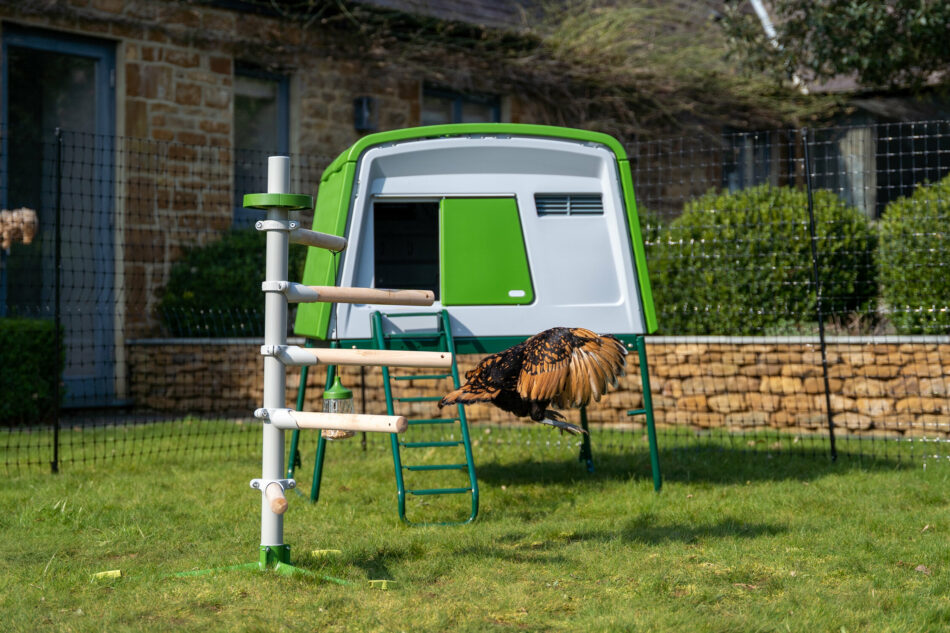

This entry was posted in Chickens
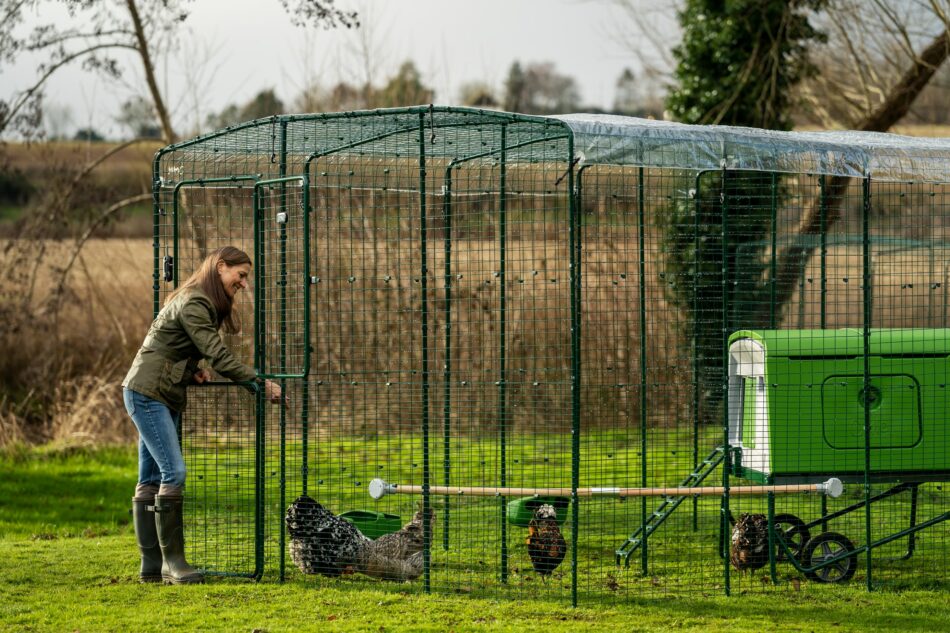
You may not find a class on raising chickens for beginners at your local college – which is why we’re here to help you get started on your chicken-raising journey. Lots of information about chicken care for beginners can be found online, but it can all be a bit overwhelming. The surest way to succeed is to stick to the basics, purchase high-quality chicken products, and to keep things simple. Omlet has the knowledge and the products to help you succeed when getting chickens for the first time.
Reasons to start raising chickens
If you’re new to poultry, getting chickens for the first time can seem daunting. Hens are often viewed as farm-specific animals whose main purpose is to lay eggs. But chickens actually make wonderful backyard pets that are full of personality and character.
There are so many benefits of raising chickens. These include, but are not limited to:
Flocks can be raised in urban or rural settings, and don’t require much space. Don’t let where you live keep you from entertaining the thought of keeping hens of your own.
Preparing for your new chickens
Getting chickens for the first time is an exciting and joyous occasion so long as proper preparations are made. There are a few things to consider before bringing home new chickens like:
- How much time you have to devote to their care
- Space requirements for your desired flock size
- Other family pets that may pose a risk to your hens
- Zoning laws and city ordinances if applicable
- Selecting your chicken coop and run
Chickens don’t require as much hands-on care as other pets do, but will still need to be looked after daily. Make sure you have adequate space for the number of chickens you want to keep – giving them as much space as possible. Secure your chickens’ area to prevent other pets or predators from reaching them.
The best beginner chicken breeds
It’s a good idea to research and decide which breeds of chickens you want to keep before bringing any hens home. Different breeds have different qualities and temperaments, but here are some that are known for being great hens for first-time chicken keepers:
Consider your climate, available space, and egg-laying expectations when selecting which breeds you want to keep. Keeping a “mixed flock” is common among chicken keepers, as it adds variety to your egg basket. You may also find “barnyard mix” hens, which are a mixture of several different breeds. These hens are often bred to be excellent egg layers, be cold or heat-hardy, or to have a specific ornamental appearance.
If you’re getting full-grown chickens, select your hens based on temperament and appearance. As with other pets, hens have unique personalities and some may be more in sync with your own personality.
Getting started with chicks vs mature hens
If you want to start your flock from chicks, it’s best to familiarize yourself with the breeds you want to keep. Once you’ve decided on which breeds you want, you’ll need to know where to find and buy your chicks. Common options include local feed stores, breeders, or even online hatcheries. No matter where you purchase your chicks from, be sure they are reputable establishments or breeders for the types of chicks you’ve chosen.
There are a lot of factors to consider when deciding whether to raise your flock from newly-hatched chicks, or to start out with established hens. Chicks require more time and resources for the first several weeks of their lives. But, raising your chickens from the start can offer several benefits as well.
Raising chicks for beginners
Raising chicks can be a very rewarding experience for any flock-keeper – beginner or experienced. Chicks grow fairly quickly, but do require extra care and equipment until they’re old enough to be more self-sufficient. To raise chicks, you’ll need:
- A secure brooder pen
- A heat lamp or brooder plate
- Chick-specific feeders and waterers
- Chick-feed and grit
With each new stage of raising chicks comes different necessities. Newly hatched chicks will need a special enclosure called a “brooder” for the first several weeks of life. A brooder should be predator-resistant and kept somewhere out of the elements. Garages, barns, or shops are ideal places to keep brooder pens. Chicks will also need a heat source (which mother hens would ordinarily provide) that is adjusted weekly to help them adjust to life outside. You can expect to house and care for your chicks in their brooder until they are around 12 weeks old.
One of the greatest benefits of raising chicks is being able to handle them from a young age. Handling your chicks daily will help to make them more docile as adult hens. After a few weeks of being handled and housed in the brooder, your chicks will be ready to be moved to their permanent home.
Choosing the perfect beginner’s coop
Aside from the chickens themselves, a chicken coop is the most important aspect of keeping chickens. And, as a beginner, you’ll want a coop that works with you, not against you. For example, DIY chicken coop plans may look appealing, but they often lack fundamental provisions for your flock. It’s important to have a safe, easy-to-clean, comfortable coop for your hens.
The process of choosing your chicken coop can be simplified by following these suggestions:
- Decide if you want your coop in a permanent location, or want the freedom of a mobile chicken coop (also known as a chicken tractor).
- Think of your yard’s space, and how large of a flock you intend to keep. If you want to keep more than 4 hens, you’ll need a large chicken coop.
- Determine how much time you want to dedicate to cleaning and maintaining your chicken coop and run. It’s important to remember that wooden chicken coops all require routine maintenance, updating, and take several hours to clean thoroughly.
Plastic chicken coops don’t rot, peel, or succumb to the elements – so they require zero maintenance. Omlet chicken coops are also incredibly easy to clean: simply remove the droppings tray and roosting rack, dump the bedding, spray or wipe clean, add fresh bedding, and place the components back in the coop. Our coops take all of the guesswork out of chicken care for beginners, and allow you to spend more time enjoying your flock, and less time cleaning and maintaining their coop.
Create space to roam with a chicken run
Chickens crave space – and lots of it. Chickens are much happier when allowed as much space as possible to explore. Chicken runs give your flock a safe space outside of their coop to peck at grass and insects, stretch their legs and wings, and soak in fresh air and sunshine.
A great option for first-time chicken owners is a walk in chicken run. These runs not only give your hens more aerial space for chicken perches, but also allow you to easily walk with your flock. Our chicken coop attached runs can be easily integrated with a walk in run, or you can simply place your chickens’ coop right inside of the walk in run.
We’ve also made it possible to extend your walk in run as your flock grows. Both the length and width can be extended at any time, giving your hens maximum space. You can also add walk in chicken run partitions to create different areas of your walk in run. This is helpful for keeping hens separated if needed or when introducing new flock members.
If free-ranging is more in line with your lifestyle, consider chicken fencing to keep your hens close to home. Chicken fencing can be used to prevent your flock from getting into flower beds, wandering off of your property, or straying too far from home. Configure a pen of any shape with posts that can be repositioned at any time, or anchor the fence to a structure with a wall mount. An easy-access gate allows you to spend time with your hens while they explore their surroundings.
What hens eat & drink
As caretaker of your chickens, you’ll need to decide what they eat and when. Chickens are fairly self-sufficient, and prefer their feed to be left out free choice. To keep your flock fed, keep their chicken feeders full of quality feed.
If your hens are laying age (16 weeks or older), they’ll need to be fed laying pellets or crumbles. Both varieties of feed offer the same nutrients, and choosing between pellets or crumbles is a personal preference. Some hens (especially small breeds) or older chicks transitioning from chick crumbles to laying hen feed may do better with crumbles.
Chicken treats can be offered when bonding with your flock, but should not make up a sizable portion of their diet. Dried mealworms are ideal treats because they contain protein and nutrients that chickens need.
Make sure your chickens have access to fresh, clean water at all times. Place your flock’s drinker high enough that bedding or dirt doesn’t get kicked in while your hens are scratching the ground, but low enough for your smallest hen to access.
Caring for your flock
Getting into a routine will come naturally after you’ve tended to your chickens for a few weeks. Coop cleaning, feeding, watering, and egg collecting are all part of the daily task list for chicken keepers. If you’re unsure about what your routine should look like, here is an example of a daily routine keeping chickens with an Omlet setup:
Morning
- Let chickens out of their coop and into their run or fencing
- Clean the coop and refresh bedding
- Feed chickens and top off waterers
Afternoon
- Collect eggs
- Check feeders and waterers (if the weather is warm, refresh with cool water)
Evening
- Close chickens in their coop once they’ve gone to roost
- Pick up and store any uneaten food for the next day (this reduces the number of visits from rodents)
Chickens thrive on routine, and will help you establish one that works for both of you. Most chickens are ready to go out of the coop at sunrise, and will naturally go in to roost around sunset. Hens will usually lay eggs in the late morning or early afternoon, but the timing will vary between chickens and seasons. It’s not common for hens to lay eggs overnight, but it’s good practice to check the nesting box each time you visit the coop.
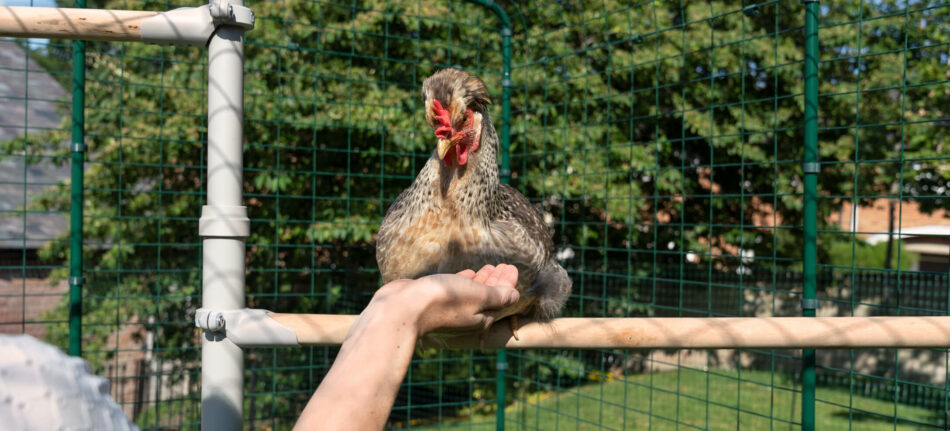
Zoning laws, predators, & protection from seasons
You’ll need to make a few adjustments to your flock’s setup depending on where you live. Luckily, Omlet makes it easy to adapt and overcome obstacles as a new chicken keeper.
Zoning laws and chickens
Before heading out and purchasing your chickens, be sure to check with your local city or county office to make sure that you can keep chickens where you live. Most states leave it up to individual cities or governing authorities such as homeowners associations (HOA) to create and enforce laws about keeping chickens.
Many cities allow chickens to be kept in backyards, but will have restrictions or requirements. These may include:
- Flock size
- Coop type and location
- Prohibiting roosters
If you’re part of an HOA, they may have additional regulations apart from the city you live in. Once you’ve obtained permission with the city, check your HOA bylaws or contact a board member to see if you can keep chickens.
Omlet has a chicken coop for every size flock to accommodate size regulations. And, with optional wheels and handles for every coop and attached run, you can move your Omlet chicken coop around your yard to comply with guidelines. Since our coops aren’t permanent structures, it’s unlikely that you’ll need a permit or a cement pad to place one in your backyard.
Chicken predators
Chicken predators are an unavoidable part of keeping a flock. No matter where you live you’ll encounter predators that will try to take advantage of hens that aren’t fully protected. From coyotes, foxes, and bears in the country, to racoons, hawks, and even neighborhood dogs and cats inside of city limits, you’ll need to fortify your flock’s home. Some common predators you may encounter include:
- Coyotes
- Raccoons
- Hawks or other birds of prey
- Foxes
- Cats and dogs
- Snakes (mainly in search of eggs, but some species will go after hens)
Make sure your chicken coop doors are secure and have mechanisms that can’t be pried open by pesky paws. Installing an automatic chicken coop door adds an extra layer of protection between your hens and predators trying to get in a closed-up coop. The horizontal open and closing mechanism helps prevent the door being pried open – unlike vertical opening doors.
Omlet has also taken protective measures against racoons. Raccoons are known to use their hand-like paws to turn knobs and levers, or reach through wire to get to their prey. The tightly spaced wire across the bottom of our Eglu Cube attached run prevents them from reaching your hens. The Eglu Cube also has raccoon-resistant access door handles that also double as child-safety locks.
Seasonal protection
As outdoor pets, your chickens need different care during different times of the year. Most chicken keepers elect to cover their chickens’ runs to protect them from the elements. Omlet’s line of heavy-duty chicken run covers offers protection from rain, snow, wind, and harmful UV rays. Our solid covers are perfect for providing shade on a hot summer day, while our clear covers allow sunlight to filter through to warm your hens during the chilly winter months.
The temperate weather of spring and fall is favorable for hens, depending on your location. And while most breeds of chickens tolerate both high and low temperatures, if your area experiences extreme temperatures you’ll need to take additional measures to keep your hens comfortable.
To keep your hens cool in the summer, make sure they have plenty of water and shade. Offer treats to help your hens cool off, like frozen corn or fresh melon. Omlet’s chicken coops keep hens cool through thoughtful design, and will help your flock weather the warm summer nights.
During extreme cold temperatures in the winter, consider adding an extreme temperature jacket to your chickens’ coop. While our Eglu chicken coops are designed to keep the inside temperature at a comfortable level, your hens will appreciate the extra layer of insulation during the bitterly cold months. Be sure to also offer your hens plenty of perching space as reprieve from the frozen ground. Offer warming chicken treats to keep their metabolisms up and to promote egg laying.
Encouraging egg production as a beginner
Egg-laying breeds of chickens will produce approximately 1 egg every day and a half. That means that during peak laying age (around 2 years old), high-producing egg layers can give between 300-350 eggs per year. But do they need your help to accomplish this?
Many first-time chicken owners wonder what they can do to encourage hens to lay eggs. The main components to help keep hens happily laying are:
- Quality feed
- Fresh water
- Adequate space
- A clean environment
- Feeling safe
If these needs are being met, your hens should lay on a regular schedule, routinely providing fresh eggs for your family. Once collected, fresh eggs can be stored at room temperature or in the fridge for several weeks. You may want to display your hens’ hard work in your kitchen by using an egg skelter. This handy device not only shows off your flock’s natural works of art, but also helps you organize and use your eggs from oldest to freshest.
What first-time chicken keepers should avoid
Chickens can make wonderful, entertaining pets that offer enjoyment to any family – so long as expectations are realistic and preparations are made. Before diving into the world of chickens, remember:
- Chickens may want to interact with their human caretakers, but aren’t as hands-on as other pets, and may not crave attention
- Buy a quality setup that won’t rot or deteriorate over time – it’s worth the investment
- Flocks are kept outdoors year-round, so be sure adjust their accommodations accordingly as the temperatures change
- Don’t attempt to raise your flock from chicks unless you have a safe place for a brooder, and can spend 2-3 months at home to look after them until they can be moved into their permanent coop and run
- Always check with governing authorities for permission before obtaining chickens or a coop
- Research the breeds you want to keep before bringing them home
- Most importantly – have fun!
Begin keeping chickens with Omlet
Getting started with chickens doesn’t have to be stressful. Let Omlet help you on your chicken-keeping journey. Explore entertaining elements like our Chicken Swing or Customizable PoleTree Chicken Perch for endless entertainment for both you and your flock.
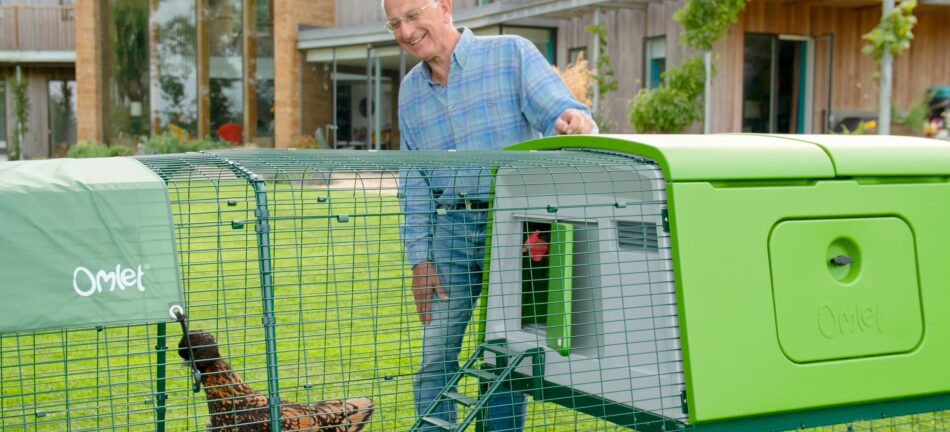
This entry was posted in Chickens
Are you considering welcoming new chicks to your home? We caught up with our friends at Meyer Hatchery for their advice on how you can best prepare and care for your new arrivals.
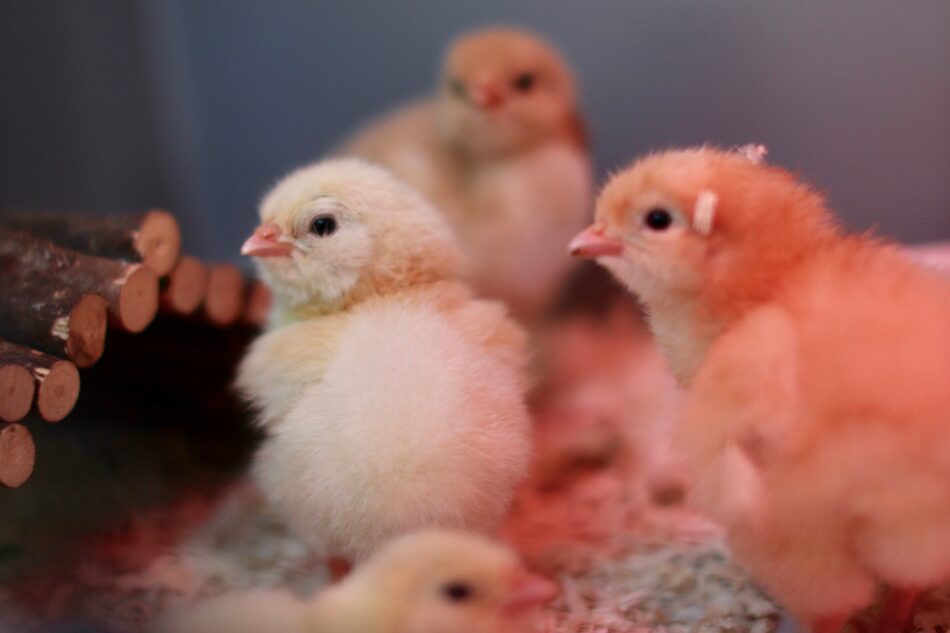
Getting new chicks is an exciting time, even more so if it’s your first time raising them. It’s important to read up on how to properly care for your new bundles of fluff so they grow into great laying hens for you. Here’s a brief primer for you on what to prepare for them, what to watch for in their health and wellness, and a timeline for moving outside into their coop.
Before arrival: set up a warm brooder
Large plastic storage totes work best to set up a brooder for 3 to 8 chicks. The tote can be easily sanitized before and after use; they are waterproof and serve as a handy storage box for the chick feeder and waterer after your chicks are grown and moved out into their coop.
Chick brooder shopping list
- Large plastic tote
- Pine shavings (caution: not cedar, it may harm chicks)
- Heat lamp with the bulb or brooder warming plate
- Chick-sized feeder
- Chick-sized waterer
- Digital thermometer with an easy-to-read display
- Chick starter food
- Optional – heat lamp stand
Place a 1-inch layer of pine shavings in the tote. Fill the waterer and feeder and place them in the brooder. Turn on the heat lamp or warmer plate and place it in the center of the brooder. Place the thermometer on top of the pine shavings in the center of the heat lamp’s spotlight.
Warning: If you use a heat lamp, make sure that you use at least two ways to secure the heat lamp over the brooder. The heat lamp usually comes with a clamp attached, but this clamp can fail or be knocked loose as the chicks grow and get more active. We recommend using a heat lamp stand and chain to secure the heat lamp by the hanging bracket, and then also secure the lamp again by using duct tape to secure the power cord to the stand as a backup.
Brooder temperature by week
- 95 degrees F at 0-7 days old
- 90 degrees F at 8-13 days old
- 85 degrees F at 14-20 days old
- 80 degrees F at 21-27 days old
- 75 degrees F at 28 days to 5 weeks
- At 5 to 6 weeks of age, chicks are feathered well enough to begin the transition to
outdoor temperatures. Turn the heat lamp off during the day. Monitor overnight low
temperatures and give overnight heat depending on the season.
At chick arrival
Place the chicks in their warm brooder. Carefully dip each chick’s beak into the drinking water. This encourages them to begin drinking. Chicks will not eat and drink until they are thoroughly warmed up. If the chicks are closely huddled in a tight ball under the heat source and chirping loudly, they are too cold. If they are giving quiet, happy little chirps, testing the food and water and exploring their new environment, they are comfortable. If they are spread to the far corners of the brooder, the temperature is too hot.
Daily care
Change their drinking water daily. Fill the feeder as needed. As the chicks grow, you may need to elevate their waterer on bricks to help keep the shavings out of the water. If using the heat lamp, raise the lamp to lower the temperature in the brooder. Monitor the chicks for signs of pasty bottom and deal with it promptly. If you have any chicks that appear to be lethargic, You may find our tips on reviving a weak chick helpful.
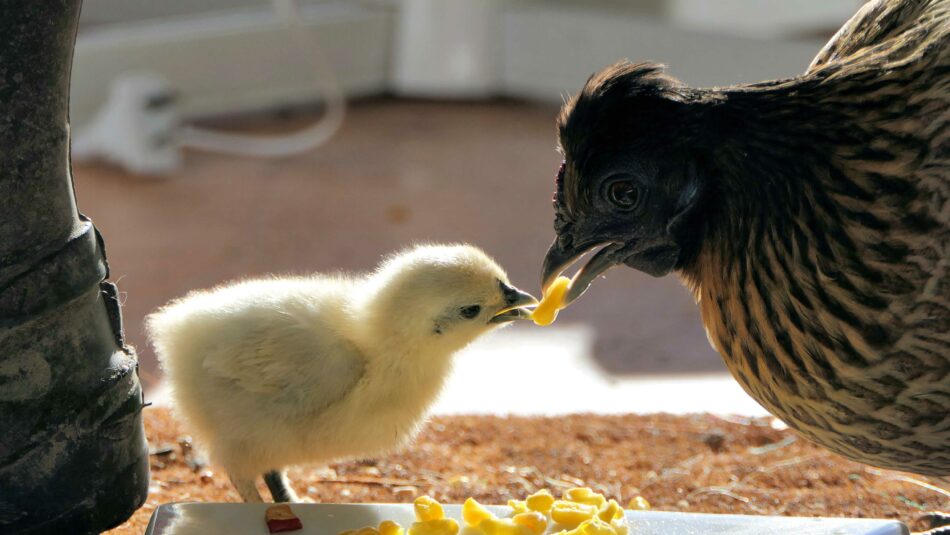
This blog was written by Meyer Hatchery.
This entry was posted in Chickens
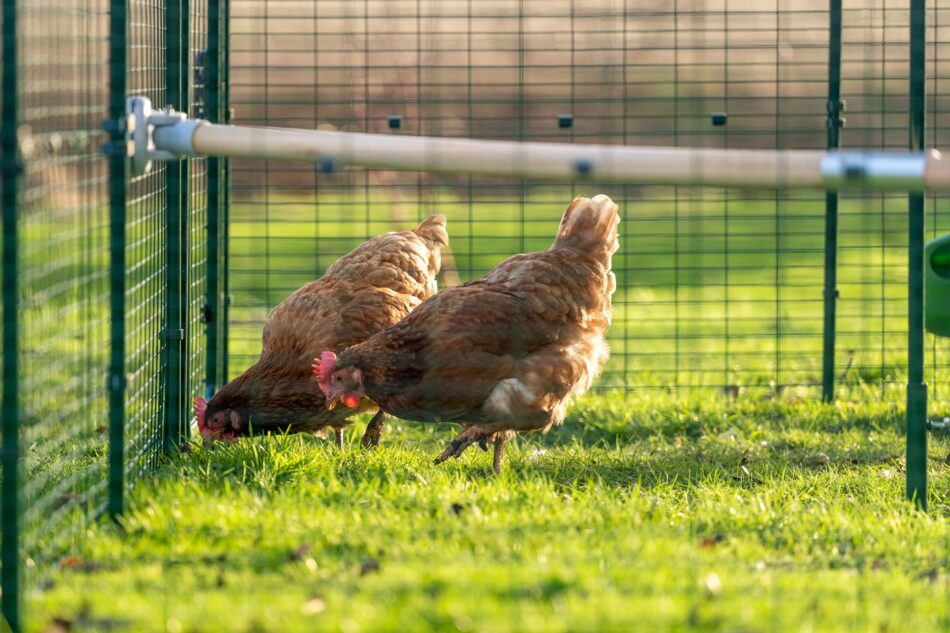
Wondering how to start keeping chickens? Chicken-keeping is an exciting endeavor for people from all walks of life, and in any location. Backyard flocks are growing in popularity across the globe – winning the hearts of millions of chicken owners. Most people don’t realize that chickens are actually full of personality, can bond with their owners, and are very enjoyable as pets. They can learn basic tricks, are excellent at pest control, and make beautiful additions to gardens and backyards as living art. And, as an added bonus, hens can provide fresh eggs for your family on a daily basis.
Ready to take the plunge into keeping poultry as pets? With the right products from Omlet and some preparation, keeping chickens can be an easy and enjoyable hobby for your entire family.
Chicken-keeping basics
We’re excited to help you get started keeping chickens! And, we’re sure you have lots of questions about chickens and their care. Learning is part of the fun of keeping chickens, and we’ll provide you with the knowledge you need to be successful from the start.
Choosing the right breed
Like many pets, there are many different breeds of chickens. Some are “good layers”, meaning they produce lots of eggs, and some are “ornamental”, being prized for their unique looks and characteristics. Hens come in various sizes and colors, and most breeds get along with others should you decide to keep a mixed flock.
Starting with hens vs. chicks
Some people choose to start with adult hens rather than with young chicks. There are benefits to each, but first-time chicken keepers will likely find the most success with adult hens. When you start out with hens:
- You know the gender of your birds, whereas most breeds of chicks cannot be sexed until they’re older
- Adult hens will already be laying eggs
- Chicks require a minimum of 6-8 weeks in a special pen called a “brooder”, and must have a heat lamp or brooder plate during that time
- You can pick adult hens from a flock based on personality and color, while chicks will take time to develop these traits
- Chicks shouldn’t be left unattended for long periods of time, such as out-of-town trips, while hens are self-sufficient when left in a secure coop and run with enough food and water
Ultimately, it’s up to you to decide if you want to start with chicks or hens. Keep in mind that chicks are heavily reliant upon their human caretakers – for everything from food, clean water, and a constant heat source. Adult hens are much more resilient and require less of your time, so if you’re completely new to chickens, it’s usually easier to start with adult hen
Lay the groundwork
Consider where you’re going to house your hens. You’ll need to find as level of a place as possible in your yard or garden to set up their coop, and ensure that their area is free of any potentially dangerous vegetation. Chickens are marvelous insect-eaters, and will also gladly help with landscaping if left to forage around. Check to make sure your flock doesn’t have access to any plants that are toxic to chickens.
If your chickens will be in one place consistently, you’ll want to choose bedding for the base of their run. Wood chips, coarse sand, or hemp bedding can be used to line the bottom of your flock’s run to keep them out of the mud.
Use a plastic chicken coop
Now that you’ve decided on what type of chickens you want to keep and where you’d like to keep them, it’s time to get the most important piece of chicken-keeping equipment: their chicken coop.
A quality chicken coop of any type is an investment, but a plastic chicken coop will last much longer than a wooden chicken coop. Not only that, but plastic coops are immensely easier to clean than wooden coops, and require no upkeep.
Omlet’s Eglu Cube will never rot, need repainting, or re-roofing like traditional wooden coops. Plastic chicken coops are quickly replacing their wooden predecessors now that the chicken-keeping world knows not all chicken coops rot.
Most chicken keepers are not fond of coop cleaning day, but the Eglu Cube has flipped the script on this previously dreaded task. In just minutes, your Omlet chicken coop can be cleaned with minimal effort. Simply remove the bedding tray, dump into your compost or garbage, and spray the tray with a pressure washer or a chicken-safe disinfectant to wipe clean. Refresh the bedding, replace the tray, and your chickens’ coop is sparkling clean once more!
The Eglu Cube might be Omlet’s largest chicken coop, but that doesn’t mean assembling it is hard. In fact, the Eglu Cube is easy to assemble and is ready for your hens as soon as it’s put together. And, with options like wheels and handles that can be added quickly during assembly, your chickens’ coop can be fully mobile.
Invest in a sturdy chicken run
If your hens need a space to call their own, you can opt to attach a run to the Eglu Cube. Their run can be extended in increments with our Eglu Cube Run Extension Packs. Or, if your space allows, consider a Walk In Chicken Run for your flock.
All of our chicken runs have anti-dig skirting that helps prevent predators from tunneling in, and are constructed of heavy-duty welded wire instead of flimsy mesh. Omlet chicken runs are designed to withstand the elements, predators, and weather events. Add optional chicken run covers to give your hens shelter from rain, snow, sun, and wind. Or, add a cover for your Walk In Run to fully shield your flock from the elements.
An automatic coop door is a chicken-keeper essential
One of the best things you can add to your chickens’ setup for both you and your flock is an Autodoor. This coop concierge lets your hens out in the morning and tucks them in at night – so you never have to worry about getting out of bed or being home by a certain time. And, the unique horizontal opening mechanism of the Autodoor by Omlet adds an extra layer of security to your chicken coop. Predators will be stumped by the sturdiness of our firm-sealing Autodoor.
The Autodoor can follow a schedule determined by the sun or the clock. Simply program your Autodoor on the easy-to-use control panel to follow whichever type of schedule you prefer. Multiple daylight options can be chosen, closing at or before dusk, and opening when the sun rises or shortly after. The time schedule is easy to follow, allowing you to select specific hours for the Autodoor to open and close.
Add an optional coop light to give your flock a soft glow to help them head in for bed. The coop light comes on 5 minutes before the Autodoor is scheduled to close. Chickens naturally gravitate toward light when the sun sets, so a night light helps stubborn hens in particular find their way to the roost when it’s bedtime.
Chickens need entertainment, too
Chickens are low-maintenance pets, but still enjoy entertainment. Mental and physical stimulation is great for helping your hens stay healthy and happy. Plus, added accessories make it that much more enjoyable to watch your hens play and exhibit their natural behaviors.
Let your hens play with their food
Omlet has a variety of Chicken toys & accessories. Accessories like the Chicken Peck Toy are great for elevating snacktime and keeping the bottom of the run clean. Keep scratch grains and other small treats inside the peck toy to make rations go farther and reduce waste.
The Caddi Treat Holder is perfect for serving fresh veggies and leafy greens, or homemade chicken treats to your hens. Hang the Caddi Treat Holder from any run, and bring it inside to refill with your flock’s favorite treats.
Perches add levels of fun
Like most bird species, chickens enjoy perching to get a better view of the world around them. The Freestanding Chicken Perch can be placed anywhere, and is easy to move anytime. Convenient and sturdy screw pegs anchor the Freestanding Chicken Perch in the ground for stabilized perching. The screw pegs can easily be unscrewed for relocating the Freestanding Chicken Perch to keep your hens on their toes.
If you have a Walk In Chicken Run, Omlet’s PoleTree Customizable Chicken Perch is perfect for adding a variety of levels to your flock’s space. Add perches of various lengths, treat holders, and peck toys to hang from pre-drilled holes in the ends of the PoleTree’s smooth eucalyptus wood perches to customize your chickens’ experience. The PoleTree is perfect for utilizing aerial space in a Walk In Chicken Run, and adds visual appeal to create a truly unique environment for your flock.
Omlet and your chicken-keeping adventure
We want you to enjoy your chickens from the moment you bring them home and for years to come. That’s why Omlet has invented products that not only keep your flock healthy and happy, but are designed to bring you closer to your chickens. The Eglu Cube, Walk In Run, and Autodoor are all thoughtfully and purposefully crafted to keep flocks safe and content while making chicken keeping easy and enjoyable for their owners. Let Omlet help you get started on your chicken-keeping adventure, and enjoy the journey to the fullest.
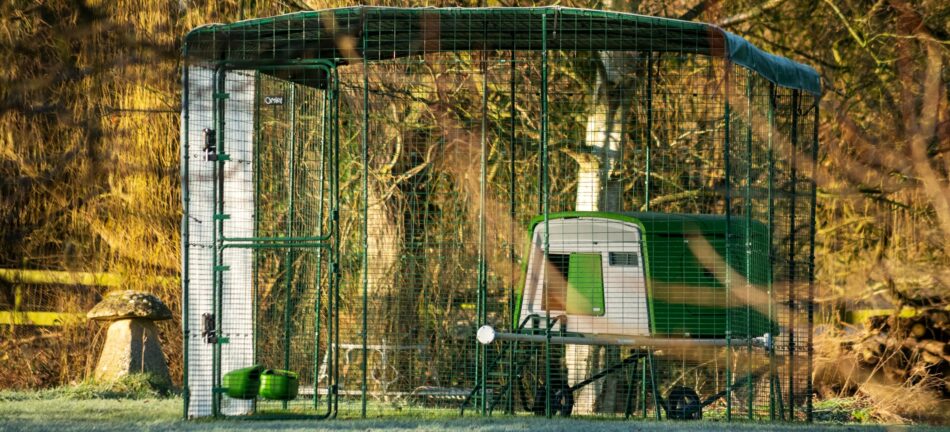
This entry was posted in Chickens
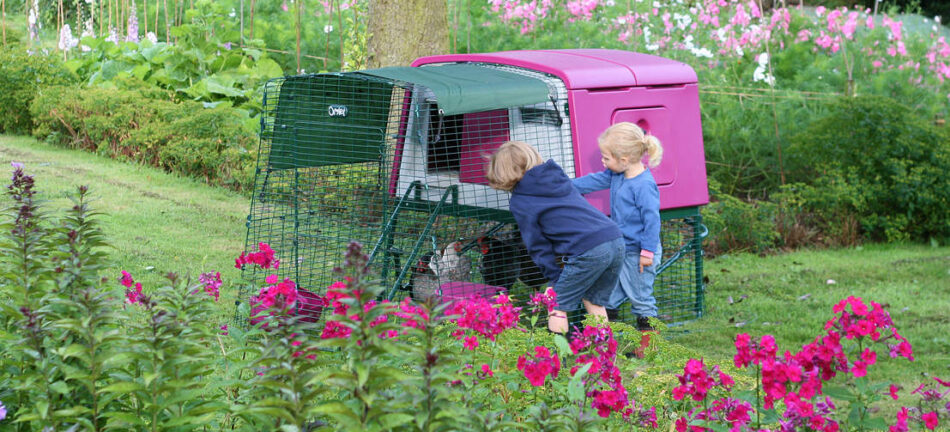
There’s a new dilemma that chicken keepers are faced with: whether to invest in a plastic or wooden chicken coop. Wooden chicken coops are common, but plastic coops are rising in popularity due to their low maintenance and ease of cleaning. Maintaining and cleaning wooden chicken coops is costly and time-consuming – but Omlet’s plastic chicken coops are saving chicken keepers both time and money.
Comparing wooden vs. plastic chicken coops
There are some major differences between wooden and plastic chicken coops. Ultimately, it comes down to which type of coop best fits your budget and lifestyle, but we’ll help you decide how to choose your chicken coop with a visual list of pros and cons for each.
Wooden chicken coops
Pros:
- Lower upfront costs
- Readily available at many chicken supply stores
- Traditional look
Cons:
- Difficult to clean thoroughly
- Absorbs moisture, which can lead to mold or mildew
- Porous, grooved surfaces attracts and harbors mites
- Drafty (particularly dangerous in the winter months)
- Requires maintenance such as repainting and roof or board repair and replacement
- Hardware cloth or chicken wire is stapled into the wood, which loosens over time, making it easier for predators to push their way in
- Difficult to move once in place
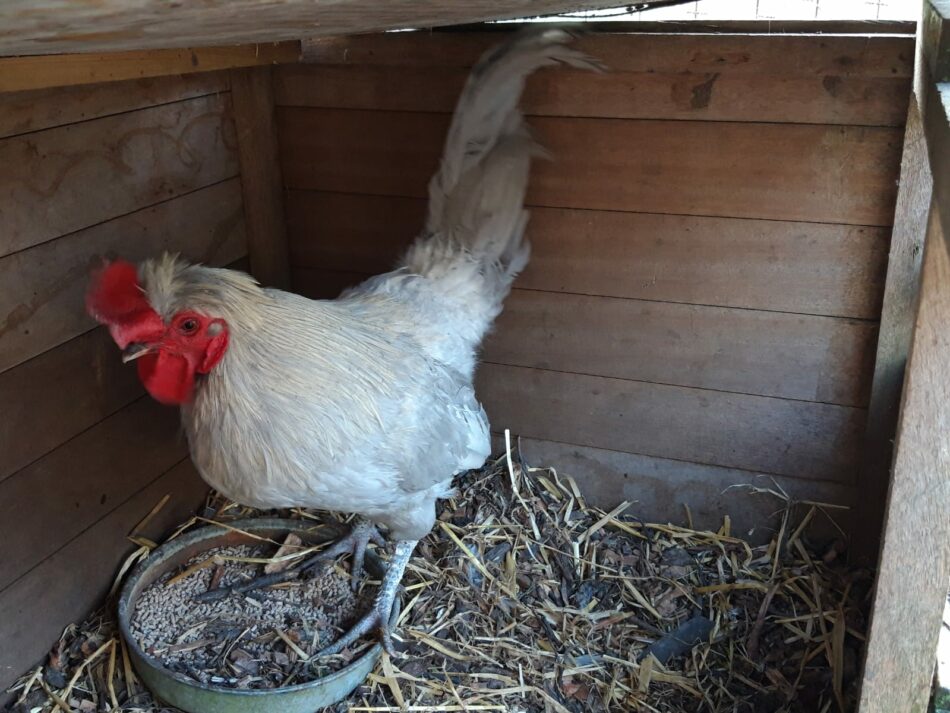
Pros:
- Easy to clean
- Waterproof
- Twin-insulated to keep your chickens cool in summer and warm in winter
- Draft-free ventilation that keeps humidity levels down inside the coop
- Inhospitable environment for mites to thrive
- Zero maintenance required
- Doors that are easy for humans to open, but difficult for predators to infiltrate
- Attached chicken runs are made from welded wire mesh connected by heavy-duty clips
- Bold, modern look
- Easily moved with added wheels and handles
- An all-in-one chicken coop, designed to last a lifetime
Cons:
Moving your coop
At some point, you may want to relocate your chicken coop. It may be to a new spot in your yard, out of necessity for safety, or when moving to a new home. Wooden chicken coops are difficult to move once they’ve been constructed, and often are too heavy to move efficiently without taking them apart. Commercially bought wooden coops are often constructed from tongue and groove planks, which do not hold up when moved.
Omlet’s mobile chicken coops can be moved easily by one person with the use of integrated handles and wheels. This is particularly helpful in areas that experience severe weather such as tornadoes, hurricanes, or flash flooding when notice is often in short supply.
Chicken tractors enable you to give your chickens a new patch of grass to forage through, or relocate your flock should the need arise. Simply engage the wheels, then use the handles to push or pull your hens’ home to a new spot. Disengage the wheels, and your hens are ready to peck their way through their new turf – without ever having to leave their run!
Customizing your chicken coop
Plastic chicken coops offer customization options that wooden chicken coops simply can’t. Additions of walk in chicken runs can expand your flock’s space and can continue to expand along with the number of chickens you have. You can also automate your chickens’ schedule by installing an automatic chicken coop door.
These accessories can be added to a wooden chicken coop, but the structural integrity of wooden coops becomes compromised after time in the elements, making them a less-than-perfect match. A plastic chicken coop designed to last a lifetime is not limited to a short timeframe for upgrades and customization.
Coop cleanliness
It’s important to regularly clean your chicken coop – no matter the material. Chickens themselves don’t smell, but their droppings do! Coops that aren’t clean attract flies and other pests that affect both you and your flock, and harbor bacteria that can bring harm to your flock.
Wooden coops need to be washed, but wood is porous and difficult to clean. Droppings usually need to be scraped off with a putty knife, with surfaces then sprayed with a chicken-safe disinfectant. Because wood absorbs moisture, you’ll need to allow ample drying time for any products or water applied to a wooden coop. Once dry, wooden coops need to be treated for mites after each cleaning with chicken-safe antiparasitic sprays or powders.
Plastic chicken coops can be deep cleaned quickly and easily. Omlet’s plastic chicken coops have removable roosting racks and droppings trays that can be pressure washed along with the entire interior. No antiparasitic treatment is needed after a plastic chicken coop has been pressure washed and wiped clean.
Predator resistance
Chicken predators are a danger that every flock raiser will encounter at some point. The sounds your hens make attract predators, as do the rodents that try to steal a snack from your chicken feeders. Even in urban backyards, chicken predators such as racoons and hawks can pray on your hens.
Wooden chicken coops usually have hardware cloth stapled around the inside of any openings. However, wood gets weaker the longer it stays in the elements, so the staples are easily pushed out of the wood from an outside force. Hardware cloth or chicken wire also rusts and weakens over time, making it prone to breaking under stress. Some wooden coops also have tops that open on hinges for you to access your hens or eggs. The problem is that predators (especially crafty ones like racoons or foxes) can lift any unlatched openings to access your hens themselves.
Omlet’s plastic hen houses have latching doors that are difficult for predators to open. They also have solid, heavy-duty walls with no wire to push in or break. Plastic is more resilient to the elements, so there’s no concern for warping or weakening over time. The attached chicken runs that are available with all of Omlet’s chicken coops are made of welded wire mesh that is treated against the elements. This heavy-duty wire does not weaken in the elements, with the panels being held together by our ingenious weather-resistant clips.
Insulation & performance in extreme weather
Chickens thrive in many environments, but the more assistance they get to regulate their temperatures, the better they weather the seasons. Heat stroke and frostbite can easily plague chickens that are kept in under-insulated coops. Depending on your climate, your main concern will be to either ensure your hens don’t get too hot in the summer or have chilly chickens in the winter.
Wooden coops need additional layers to offer sufficient insulation. Adding another wall with insulation in between can achieve this effect, taking care to allow for ventilation. Ventilation is key when keeping a chicken coop at a comfortable temperature and humidity level. Too much ventilation will allow insulated air to escape, making the coop too hot or too cold. On the other hand, too little ventilation causes moisture to build up, creating a damp, stuffy, overly warm coop.
Superior ventilation and insulation is found in Omlet’s plastic chicken coops. The twin walls trap a pocket of air (the best insulator) around the coop to help keep the temperature at a comfortable level. Mindfully placed ventilation points allow for just the right amount of air to circulate even when the coop door is closed. This reduces the humidity level in the coop and allows for fresh air to circulate.
Additional extreme weather protection for your hens can be added to Omlet chicken coops. This cold weather preparation for chickens helps your coop stay as warm as possible in the winter.
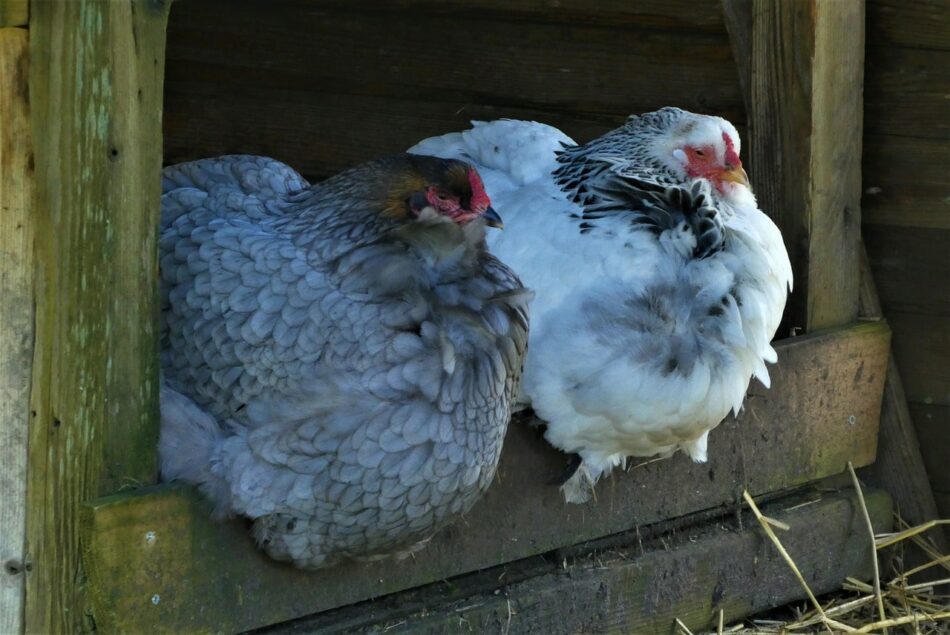
Durability – how long will a coop last?
The elements are not kind to wooden chicken coops. Harsh UV rays, soaking rains, heavy snow, and high winds all wreak havoc on traditional chicken coops. Wooden chicken coops maintain their integrity for the first few seasons, but soon you’ll notice the beginning stages of the deterioration process.
Rotting or weakening wood, faded paint, and missing roof shingles are usually the first elements of a wooden coop that fall prey to the weather. Replacing any weak planks and repainting or retreating boards with weather-resistant paint is an annual affair. Shingles can be reapplied to roofs, but it’s a sticky and time-consuming task!
Choosing a chicken coop that fits your budget is important, so keep in mind the long-term expenses that a wooden chicken coop will inevitably incur. A plastic chicken coop may cost more in the beginning but will save countless hours and dollars over the years, as they do not require maintenance.
Additionally, Omlet chicken coops are strong. So strong in fact, that real-life Omlet customers have shared stories of their coops surviving hurricanes, tornadoes, falling trees – and even the full weight of a bear! Heavy-duty plastic lasts for years, and you’ll never need to worry about rotting or weakening parts. The only maintenance needed on an Omlet chicken coop is regular cleaning and ensuring that the ground beneath the coop has not shifted to create gaps or misaligned doors.
Ease of building
Building a wooden chicken coop from scratch is a daunting task! Like any carpentry work, it must be squared off, level, and properly constructed. The supply list alone will have you making several trips to various hardware stores! How nice would it be to have everything come inside of a box, requiring only a screwdriver to assemble?
Deciding to buy or build a chicken coop relies heavily on your experience. Chicken coops (or any other animal enclosure) are not a project for beginners! Your flock’s comfort and safety depend on the design of their coop.
Thankfully, assembling an Omlet chicken coop can be done in just a few hours. Our step-by-step videos make assembly easy and enjoyable. All you’ll need is a level space and a screwdriver. Your children can even help build an Omlet coop, which will help include them in your family’s flock-raising journey.
Is a plastic or wooden chicken coop best for me & my flock?
Maybe you’re already the owner of a wooden chicken coop and thinking about upgrading to a plastic coop. Is it really worth all of the fuss? Check with your hens to see! Are your chickens happy in their wooden coop?
Unless you are meticulous with repairs and maintenance on a wooden chicken coop, your chickens would probably be happier in a plastic coop. The increased security, ventilation, insulation, and ease of cleaning that plastic coops have to offer make keeping chickens much more enjoyable. So ask yourself: are you happy with your chickens’ wooden coop? If the answer is “no”, then it’s time to upgrade to plastic!
Omlet’s easy maintenance plastic chicken coops
Omlet has a variety of high-quality plastic chicken coops to fit your flock and family’s needs. From the original Eglu Go, to our largest coop yet – the Eglu Cube, there’s a coop for everyone.
Reasons to choose a chicken coop from Omlet:
- Easy to clean, move, and customize
- Superior safety, insulation, and ventilation
- Weatherproof and predator-resistant
- Excellent customer service
- Backed by a 2-year warranty
Thousands of chicken keepers have experienced the ease of owning hens with an Omlet chicken coop. In fact, you can reach out to a local Omlet ambassador to ask them about their experience, and see their setup for yourself.
See the Omlet difference
We’ve invented coops that bring joy to chicken ownership. Keeping chickens shouldn’t be a chore – it should be a relaxing and rewarding hobby. Once you’ve decided on an Omlet chicken coop, explore our other products that are designed to complement to your coop, such as:
As always, our team of experts are ready to help you decide which coop is right for you and your flock, and to support your entire chicken-keeping journey.

This entry was posted in Chickens

Recognizing the stages of raising chickens is vital if you’re looking to grow a flock. Chickens will go through several stages throughout their journey from egg to adult, and each stage has different care requirements. Knowing how to care for your chickens during each phase of their growth will help foster the bond between you and your flock, and ensure that they are healthy and thriving.
Determining the age of a chicken
If you haven’t hatched your chickens from eggs, you may be unsure of their age when you bring them home. There are a few ways to help you determine how old your chickens are:
- Downy feathers: if your chicks are still fuzzy or fluffy in appearance, they are less than 5 weeks old.
- Adult feathers: between 5 and 6 weeks, with the majority of breeds becoming fully feathered by 6-8 weeks of age.
- Laying eggs: at least 16 weeks old
Chickens that are at least 12 weeks old are ready for their permanent homes in their comfy chicken coop and spacious chicken run. It’s important not to introduce them to a raised coop until they are at least 12 weeks old, as younger chicks don’t have the coordination or size to navigate a ladder.
Stage 1: hatching eggs
The best way to determine the age of your chickens is to hatch chicks from eggs. This is actually a relatively quick and easy process once you have the right equipment. It’s a wonder-filled educational experience for children, and when timed right, you can even witness your chicks hatching from their eggs.
Things you’ll need to hatch your own eggs:
- A quality incubator, with or without an automatic egg turner (if you don’t have a turner, you’ll need to rotate the eggs 3-5 times within a 24-hour period)
- A thermometer and hygrometer (if not included with your incubator)
- A calendar
- Fertilized chicken eggs
- Optional: an egg candler to document embryo development
Using an incubator
When hatching eggs in an incubator, it’s important to remember to:
- Mark eggs with a pencil to ensure they are being rotated properly (even if your incubator has an auto-turner)
- Open the incubator as infrequently as possible, and close the lid quickly to maintain humidity and temperature levels
- Candle eggs to check for embryonic growth
Fertilized chicken eggs can be purchased from farms or breeders, or if you have a rooster, you can collect your own eggs to incubate. It’s important to keep in mind that fertilized chicken eggs have variable hatching success rates. Not all eggs will develop and hatch, even if conditions are just right. To ensure the highest hatch rate, follow the instructions that come with your incubator as closely as possible.
Final stages of hatching chicken eggs
After 21 days of incubating chicken eggs, your chicks should start hatching. You’ll want to “lockdown” your incubator by following its instructions during the last few days of incubation. Usually, you’ll add more water to increase humidity levels, lower the temperature slightly, remove the auto-turner (if applicable) and place a non-slip surface under the eggs so newly hatched chicks can get their footing. If you want to watch your chicks emerge from their eggs, watch for “pipping” in the shells of the eggs. A chick will pip (make a tiny hole) in the shell of its egg within 24 hours of hatching. Some chicks progress quickly through the hatching process, while others take the full 24 hours. If you notice a pip in an egg, it’s best to stay close if you don’t want to miss seeing your chick hatch!
Stage 2: young chicks
Store or breeder-bought chicks can be purchased as straight runs (non-sexed) or as pullets (determined to be hens). Straight-run chicks can be purchased as early as 1 or 2 days after hatching, while pullets are a little older. Sexing chicks under 8 weeks old (and even older for some breeds) isn’t 100% reliable, but your odds of getting a rooster when purchasing sexed chicks are greatly reduced. Some breeders will even offer to swap out any roosters that were mistakenly sexed for pullets.
Essential supplies for young chicks
All chicks will need a heat lamp and a brooder pen until at least 6 weeks of age. Make sure to have a brooder pen completely set up before bringing your chicks home to avoid common mistakes when raising chickens. Things you’ll need for your brooder include:
- A sturdy enclosure with solid walls, and preferably a top to keep older chicks in and other animals or objects out
- A heat lamp
- Absorbent bedding, such as pine pellets or shavings
- Chick crumble feed
- A chick-safe waterer (a shallow, gravity-fed waterer is best)
- Chick grit to promote healthy digestion
- A thermometer to attach to the side of the brooder to monitor temperature
Chicks that have not been vaccinated for coccidiosis by a breeder will benefit from being fed medicated feed for the first 2-4 weeks of life. After that, they can transition to non-medicated chick crumbles.
Letting young chicks outdoors
At 6 weeks old, most breeds of chicks will be fully feathered with their adult plumage and ready to venture outdoors. Start with short visits in an area enclosed by chicken fencing, making sure to supervise them the entire time. You can also start introducing them to their coop and run during their outdoor visits to get them accustomed to their forever home.
Stage 3: pullets & cockerels
Once chicks reach 5-7 weeks old, most chicken breeds exhibit differences in appearance between pullets (young hens) and cockerels (young roosters). Now in their awkward teenage stage of growth, pullets and cockerels will begin growing their secondary feathers and exhibiting signs of their respective genders.
Housing pullets & cockerels
Housing requirements are the same for pullets and cockerels, as all chickens need safe spaces to roost, play, and forage. A walk in chicken run is the best option for all flocks, as it allows for plenty of space, and gives keepers an opportunity to join their chickens. All chicken pens should be predator-resistant to protect your flock from chicken predators. Your chicken coop should be able to keep your chickens comfortable all year round, easy for you to clean, and offer a safe place for your flock to roost at night. The Eglu Cube Chicken Coop checks all of these boxes for flocks of up to 10 small breed chickens.
Characteristics of cockerels
Some breeds take longer to mature than others, so the most definitive way to tell if your chick is a cockerel or pullet is to wait to see if they crow around 6-8 weeks of age. In the meantime, there may be other clues that point to your chick being a young rooster. Cockerels generally:
- Are larger in size
- Have more pronounced combs and wattles
- Have longer tail feathers
Characteristics of pullets
If your chick isn’t crowing by 8 weeks old, it may be a pullet. Check for the following characteristics to see if you may have a young hen.
Pullets generally:
- Are smaller than cockerels
- Have longer flight feathers (secondary feathers starting mid-wing, extending to the tip)
- Will start laying eggs as early as 18 weeks of age
Pullets will need to be fed laying crumbles or pellets by the time they start laying eggs. Cockerels can eat the same diet as your pullets.
Stage 4: hens & roosters
Once your chickens are fully matured, they’ll start being referred to as hens and roosters. With a few exceptions (such as Silkie chickens, who take longer to mature), the differences between roosters and hens include:
- More pronounced combs and wattles
- Longer tail feathers
- The presence of “spurs” (bony, keratin-covered protrusions on the inside of their legs)
- Crowing
Hens and roosters can usually cohabitate just fine, but it’s important to not have more than one rooster in your flock. If more than one rooster is kept in the same coop and run, fights are bound to occur. You may also notice your hens losing feathers on their neck, back, or under their tails from too much attention from a rooster. If this happens, separate the rooster from your hens until they recover. If this occurs regularly, you may need to find other permanent arrangements for your rooster.
Egg production in hens
The presence of a rooster is not necessary for egg production. Laying hens will typically produce one egg every day and a half. High egg-producing breeds can lay over 300 eggs per year. Having a safe hen house will give your hens a comfortable space to lay their eggs, which is essential for egg production. You can also encourage your hens to lay more eggs by supplementing their diet – particularly in the winter.
By now your entire flock should be eating high-quality layer crumbles or pellets as 90% of their diet. The other 10% can be made up of scratch grains, forage, fresh vegetables, and high-protein chicken treats such as mealworms.
Stage 5: retirement from laying
While most breeds of chickens have a lifespan of 8-10 years, their fertile, egg-producing years stop short of this mark. By the time a hen is 5 or 6 years of age, egg production will have drastically slowed or come to a complete halt. Hens that are well cared for will act and appear the same as in their younger days, but you may notice subtle differences such as:
- Moving more stiffly or slowly
- A thickening in the bottoms of their feet
- Fewer eggs, but larger in size
- Moving down in the flock’s pecking order
With the absence of additional female hormones, an aging hen may even acquire traits that are usually unique to roosters, such as growing spurs, larger combs or wattles, or even start crowing! This phenomenon is rare, but is not indicative of health issues in an older hen.
4 tips for first-time chicken-keepers
The most important thing to consider when getting chickens for the first time is to evaluate how much time and space you have to dedicate to raising them. If you have an enclosed area such as a shop or a barn to set up a brooder pen, then incubating or purchasing young chicks can be a rewarding experience. Or, if you’re ready to put chickens into a coop and run and collect eggs right away, then getting adult chickens would be the better option.
Whichever you choose, here are 4 tips to remember when getting chickens for the first time:
- Perform your research ahead of time. Decide on which chicken breed(s) you want, how many, and if you want only hens, or a rooster as well.
- Have all of your equipment set up and ready to go. Get to know your incubator and brooder (if applicable), coop, and run to ensure that everything is set up and working properly.
- Find support. No chicken keeper has everything figured out, but many have improved their experience through trial and error, and will have invaluable knowledge as a result.
- Have fun, and maintain a sense of humor! Chickens are enjoyable pets, so be sure to bask in the relaxing days, and keep your head up during the (rare) stressful days.
Caring for your chickens at every stage with Omlet
Omlet has products to support your chicken-keeping journey at every stage. Keeping chickens is a hobby and lifestyle for many people, and can be enjoyed by every member of the family. With flexible options like a chicken tractor, you’ll be able to move your flock around your yard or property with ease. Or, if it’s a more permanent setup you’re after, our large chicken coop can be integrated with our walk in chicken run for the ultimate safe play space.
Make your flock’s setup your own with accessories like chicken perches, a chicken swing, or a chicken toy starter bundle. These accessories can be enjoyed by chickens of all stages: from chicks up to retired hens. And, you’ll be able to enjoy watching your flock foster their natural instincts in these creative ways.
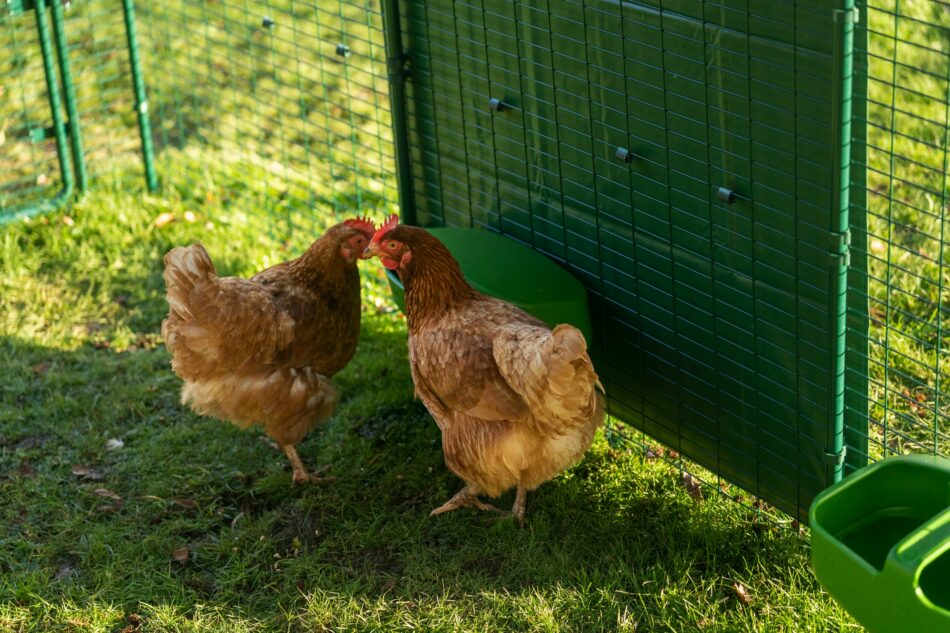
This entry was posted in Chickens
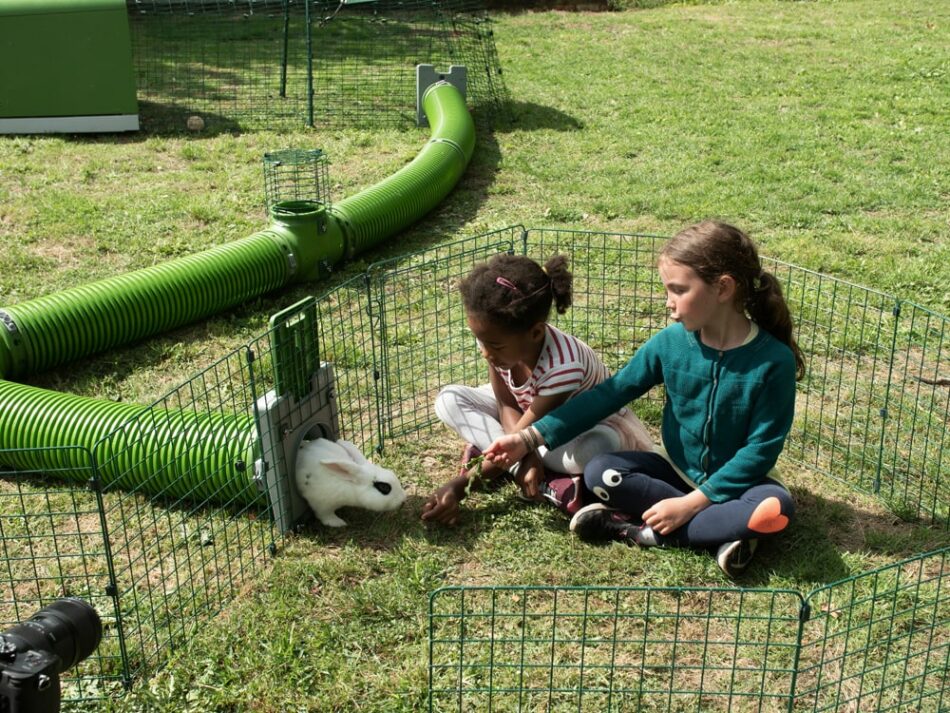 Did you know that you can raise an animal for your 4-H project? Not only that, but you can raise your 4-H project animal out in the country, or right in the middle of the city! With Omlet, raising a small animal for your 4-H project is easy and enjoyable.
Did you know that you can raise an animal for your 4-H project? Not only that, but you can raise your 4-H project animal out in the country, or right in the middle of the city! With Omlet, raising a small animal for your 4-H project is easy and enjoyable.
The National 4-H Council has many different opportunities for projects, and raising animals is part of most local 4-H groups. We’ll help you get started with your new 4-H project by helping you decide which animal would be the best fit for you. And, we’ll talk about how to care for your 4-H project animal, how to get ready for show day, and what to expect along the way.
What is 4-H?
4-H stands for: “head, heart, hands, and health.” These four aspects are what 4-H programs foster in kids ages 8-18 years old. From science, community outreach, agriculture, to healthy living programs, there’s something for everyone!
Projects for 4-H are chosen on an individual basis. These projects are completed over the course of several months, and are usually shown at an exhibition or county fair. If you’ve been to a county fair or stock show, you’ve probably seen 4-H exhibitors displaying their projects. Projects like art, leather working, welding, and livestock or small animals are commonly shown at these events.
Find your local 4-H group to see what types of projects your area supports. Most local 4-H groups will have animal projects as an option. Most animal projects are considered “livestock” under the category of agriculture, but many animals can be raised as a 4-H project. If you live in a city or are short on space, you may be particularly interested in small animals like rabbits, cavies (guinea pigs) or even chickens.
Choosing an animal for your 4-H project
Before deciding on your project, you’ll need to become a member of your local 4-H group and see which animal projects they support. Your group leader can help you choose the best animal for your project, and how and when to show them. Animal exhibitions usually take place at county fairs, stock shows, and group or association-sponsored shows. Show schedules are usually published well in advance, and can help you decide which animal you’d like to raise, and how soon you’ll need to get started.
Rabbits, guinea pigs, and chickens are great projects for children of all ages. They’re all easy to handle and care for, and come in a variety of breeds to choose from. These small animals don’t need much space, and can teach valuable animal husbandry skills to kids of all ages.
Raising your animals for your project is part of the work (and fun!) of being part of a 4-H group. Most animals need to be purchased as young as possible so that you have time to bond and fully raise your project. Rabbits, guinea pigs, and chickens all mature quickly,
Caring for your 4-H project animal
Whichever animal you choose for your 4-H project, they’ll need housing and proper care to thrive. It’s important to set up their housing and purchase their feed and accessories before bringing them home. We’ve outlined some basic care needs for rabbits, guinea pigs, and chickens to help you decide which animal project is the best fit for you.
Caring for rabbits
Taking care of a rabbit is a big responsibility, but with the right products can be easy and enjoyable. Bunnies bond with their owners, are fun to show, and there are a variety of rabbit breeds to choose from. To successfully keep a rabbit for your project, you’ll need:
It’s important that your rabbit has enough room to run and build muscle. Body composition is one of the criteria that your rabbit will be judged on, so keeping them fit is essential. Some breeds may also require mild to moderate grooming. All rabbits will need their nails trimmed routinely and given chew toys (preferably those made from apple wood) to help keep their continuously-growing teeth filed down. Handling your rabbit daily will help prepare them for their routine grooming sessions and for the show table.
Caring for guinea pigs
Taking care of guinea pigs is similar to caring for a rabbit. The exception is that while rabbits can thrive being kept by themselves, guinea pigs do best in pairs. To avoid unwanted litters, make sure to get two guinea pigs of the same gender! You may not necessarily show both of them, but it’s best to get your pair while they are young so that they can bond and mature together.
To care for guinea pigs, you’ll need:
Like rabbits, some guinea pig breeds will require grooming beyond regular nail trims. Handle your guinea pigs daily and help them get used to being placed on a table for showing. Omlet’s Guinea Pig Platforms are a great tool for getting your cavies used to being on a table-like surface.
Caring for chickens
Taking care of chickens is surprisingly easy once you understand their basic needs. Even though they’re commonly associated with farms, chickens can actually thrive in urban settings too. Since chickens aren’t common backyard pets in cities, make sure you check with your city zoning office to get permission to house chickens, and if there are housing requirements for your flock.
Chickens need:
There are many different breeds of chickens to choose from. If you choose laying hens to show, you’ll get to benefit from fresh eggs once they’re old enough to start laying. It’s important to remember that chickens are flock animals by nature, so you’ll want to keep a minimum of 2-3 birds at a time.
Breed-specific care
Each breed has their own standards by which they will be graded on by a judge. Their coat or feather coloring and patterns, body composition, conformation, overall health, and size will all be taken into account. It’s also important to choose your project animals from reputable breeders.
Some flaws in breed standards will be grounds for disqualification or score docking. While mixed breeds make excellent pets, only purebred animals are allowed to be shown. Once you’ve selected the breed of rabbit, guinea pig or chicken that you’d like to show, familiarize yourself with the breed standard so that you can select quality animals. You may want to ask your 4-H leader or other seasoned-show person to go with you when you pick out your young animal.
Preparing for your show
You’ll have your project animals for months before showing them, which gives you time to prepare both yourself and your animals for show day. Your 4-H group will likely have meetings that are held regularly to support you throughout your journey. Some meetings may require you to bring your animal along with you so that your leader can check their progress.
Rabbits, guinea pigs, and chickens will all be weighed on show day, so it’s important to weigh them at home to make sure they’re getting proper nutrition. Keep a record of each weighing session to share with your 4-H leader so that they can help you determine if your animals are over or underweight.
For the majority of the show, your rabbit, guinea pig, or chicken will be placed in a wire cage until it’s time for the judge to handle them. Practice having your animal stay in the same cage that you will use to transport them to the show a few times each week to get them used to being confined outside of their hutch and run.
When it’s your rabbit, guinea pig, or chicken’s turn, the judge will remove them from their wire cage and handle them. They will place them on a table, feel their muscles and fur or feathers, and look at their overall appearance. Ask your 4-H leader to help you with proper table placement and how to hold your animals the same way the judge will. A well-mannered, trained 4-H animal stands out to a judge!
What to expect after the show
You may have offers from potential buyers for your rabbit, guinea pig, or chicken after a show – especially if they’ve won a ribbon! It’s completely up to you if you’d like to sell your project animal, or if you’d like to continue on with their show career. Some people sell their animals at a show in order to try a different breed or type of animal for their next project. Others may decide that they want to keep their project animals as family pets, or as breeding stock for future projects.
If you don’t have offers for your animals at the show, that’s okay too. You can still decide to sell them later, or keep them as family pets. Take notes from the judge to review and see if the marks are something your animal can overcome through nutrition or exercise. If your animal was disqualified for not having breed-standard coloring or build, then they should be retired as a beloved family pet.
No matter the results, you should feel immense pride after completing your first show! Lots of time and effort goes into taking care of animals – whether they be show animals or family pets. Some of the great opportunities 4-H has to offer are teaching children responsibility, hard work, and dedication. And, sometimes not winning a ribbon is one of the greatest learning opportunities of all.
Omlet and your 4-H animal project
Omlet has housing solutions for your 4-H animal projects. By having easy-to-clean hutches and coops, you can keep your animals’ home clean and comfortable in minutes, saving you valuable time to train and work with your rabbit, guinea pigs, or chickens. Choose from our line of enriching products to build both your relationship with your 4-H project animals and their muscles:
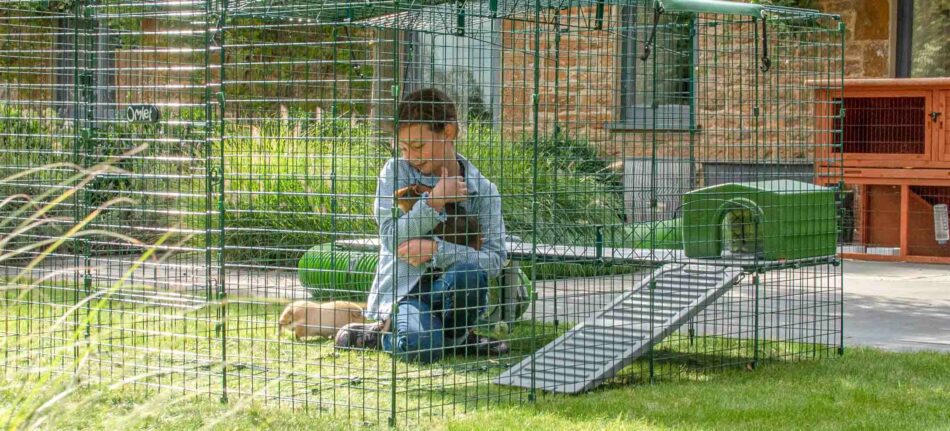
This entry was posted in Chickens
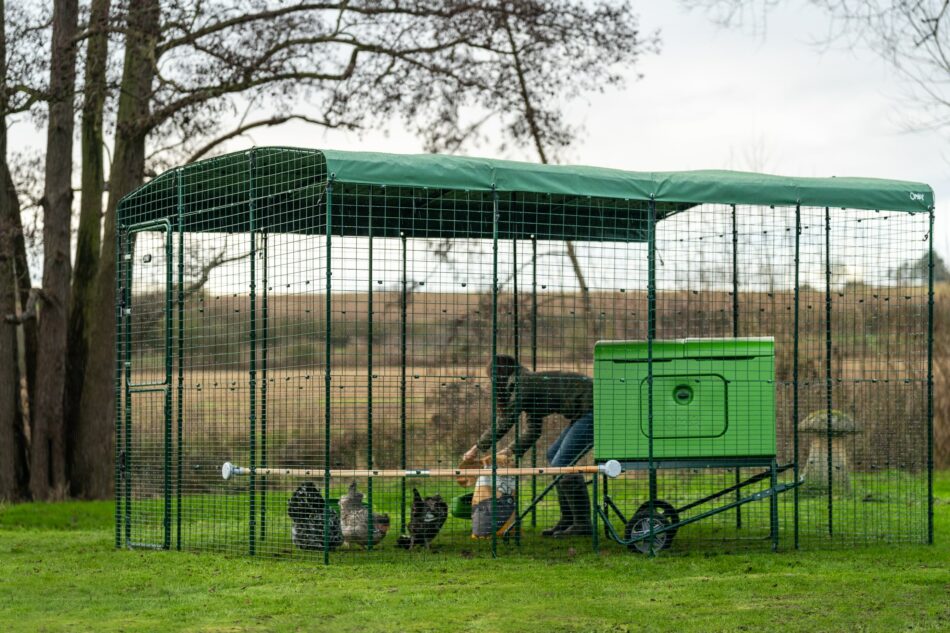
Caring for chickens is a rewarding experience for all ages. While commonly associated with farms and barnyards, chickens are rising in popularity as backyard pets. And why not? Birds of various species are kept as beloved pets, and chickens are part of the avian family. With Omlet’s help, you can learn how to care for your chickens in the best way possible, from which housing will keep them safe, to the best feed.
Why you should keep chickens
Chickens make for unique and relatively low-maintenance pets. With the right care, hens can provide a family with fresh eggs all year round. Quality hen housing, food, fresh water, and simple cleaning routines are essential to helping your chickens thrive. But we’re just scratching the surface here – let’s dig into caring for chickens with tools to ensure success for your flock-raising journey.
Are chickens easy to take care of?
As long as your flock’s requirements are met, the rest of their routine is entirely up to you! The basic needs of chickens are:
Do chickens require specific veterinary care?
Chickens don’t require annual vaccinations like other household pets. Deworming can be done on a routine basis, but can usually be accomplished through feeding herbs and other natural anti-parasitic measures. Feed stores also carry deworming agents that can be added to your flock’s feed or water, but be sure to ask your veterinarian before choosing a dewormer.
It’s always a good idea to have a veterinarian that is familiar with chickens lined up before bringing your chickens home. A veterinarian can also be a great resource when deciding on what breeds to get and finding the right breeder.
Are chickens social animals?
Hens are social animals with each other, but don’t require daily interaction with humans to thrive. While they’ll certainly enjoy the snacks and treats you bring them, they don’t crave human interaction. But as most chicken keepers will agree, spending time with your hens is a relaxing and enjoyable experience. Having chickens in your backyard is similar to tending a garden – you can customize their space, choose the color or types of hens you keep, and reap benefits in the form of fresh eggs.
Caring for chickens: the essentials
Though they’re hardy and adaptable, chickens still need a helping hand from their keepers to stay safe and comfortable. Chicken essentials should be selected with care, as they are not all created equal in terms of safety, benefits for the keeper, and functionality.
Coops and runs
A coop is an absolute essential when keeping chickens. Chickens naturally seek a place to roost at night, a safe nesting area, and shelter from the elements. A good chicken coop will fulfill all of those needs, but an excellent chicken coop will have added benefits for you as well. Some additional features that will make chicken keeping more enjoyable for you inlclude:
- An easy to clean chicken tractor
- A mobile chicken coop for flexibility
- Increased coop insulation and ventilation to bolster hens’ health
- Limited maintenance
- Waterproof and free from drafts
- Dedicated nesting area for collecting eggs
Choosing your chicken coop comes down to personal preference, but be sure to consider all of the benefits before making your final selection. Also, take into account what size chicken coop you’ll need. Some breeds of hens get larger than others, so you’ll need to select a large chicken coop that will accommodate your flock comfortably.
Another important component of keeping chickens is a chicken run. Most hen keepers prefer a walk in chicken run so that they can easily spend time with their flock and see to their needs. Omlet’s walk in chicken runs are heavy duty, with roof panels and anti-dig skirting for top-to-bottom security. It can also be added onto to accommodate growing flocks.
Caring for free-range chickens
Alternatively, you may want to let your chickens free-range. However, this term can be a bit misleading. Traditionally, “free range” implies that chickens are not limited by any fences and are allowed to roam as they please. There are a few concerns with this method of keeping chickens, namely the danger it poses to flocks. Chicken predators are abundant, and without means to deter them, your flock is left vulnerable.
Chickens can still be considered free ranging if they have access to grass, insects, and vegetation. The definition of “free range” in the US are flocks that have outdoor access. This can be accomplished with a walk in run, or with chicken fencing. While chicken fencing isn’t as predator-resistant as a run, it still keeps your hens from wandering too far from safety.
Food and water
There are many different types of chicken feed and methods from which you can choose from to supply nutrition to your flock. Do you want to feed your hens organic feed? Non-GMO feed? A free-range diet?
If you plan to sell your hens’ eggs as organic or non-GMO, be sure to check with your state’s guidelines to ensure you have the proper feed and/or licensing. Most states require additional certification or specific types of feed to be fed to flocks in order for them to be marketed as organic or non-GMO. Free-range hens should also be offered supplemental feed to aid in egg production.
Your laying hens’ feed should consist of a minimum of 16% protein. Chicks should be fed with feed consisting of 18-20% protein until they reach laying age. Additional protein can be offered in cooler months, or during molting cycles.
The most common forms of feed are:
- Pellets or mini pellets
- Crumbles
- Whole grain
- Mash
The best ways to give feed to your chickens
As chickens tend to pick through their food, offering their feed in covered chicken feeders will help reduce waste. Chickens can have their pellets left out free-choice, and are not in danger of overeating. Be sure to check their feed levels regularly and top off as needed.
Scratch grains or fresh chicken-safe produce can be fed in chicken treat dispensers to add nutritious variety to your flock’s diet. These treats should be offered as a supplement to laying feed, and are helpful when bonding or working with your hens. Some chickens are very food-motivated!
Fresh, clean water should always be available to your flock. Skim any debris from your chickens’ water if needed, and replace their water every 2 or 3 days to maintain freshness. In the warmer months, chicken-specific electrolytes can be added to keep your hens hydrated.
Entertaining the flock
Chickens are curious by nature, and love to explore, which makes them very enjoyable to observe. Being the inquisitive characters they are, they will seek out entertainment opportunities, and can quickly become bored without enough engagement from their surroundings. Bored chickens can turn to undesirable behaviors such as pecking (themselves or each other), aggression, and can even become listless or lethargic. In short: a bored hen is not a happy (or healthy) hen!
There are several features that can be added to your flock’s run to encourage their natural tendencies and exercise both their minds and bodies. Some accessories that will enrich your run include:
By creating an environment that fosters your flock’s natural behaviors, you can keep them safe and happy inside their run full-time. Plus, there’s nothing quite like watching your hens relax on their swing or explore the height of their run on their perches.
Protection against predators
Even if you live in an urban setting, chicken predators can be abundant. When visualizing animals that would prey on chickens, it’s easy to see bobcats, bears, foxes and coyotes as potential threats to your hens. But racoons, hawks, snakes, and even neighborhood cats will take advantage of an unsuspecting flock in your own backyard.
It’s important to have a predator-resistant chicken coop and run, complete with anti-dig skirting to help keep predators at bay. As an added layer of protection, an automatic chicken coop door can be added to your hens’ house to ensure they’re enclosed every evening – even when you aren’t home. Omlet’s Autodoor offers additional protection in the form of a horizontal closing mechanism, making prying the door open nearly impossible for predators.
Keeping hens healthy
Daily check-ins with your flock are essential for staying on top of their health. A healthy chicken is bright, alert, and responsive, with no visible or audible issues. Quickly checking in with your hens will usually be enough to notice if something is amiss with them. Many illnesses that occur in backyard flocks can be treated, so it’s important to quickly relay concerning symptoms to your veterinarian.
Avian flu is on the minds of lots of chicken keepers, but can largely be prevented with a few modifications to your chicken run. Covering your flock’s outdoor space with a waterproof tarp is one of the best preventative measures to take against avian flu. Ask anyone who has their own birds at home (of any species) not to go in with your chickens. This is helpful in preventing not only avian flu, but other bird-borne illnesses as well.
What to know when keeping baby chicks
Chicks require special considerations apart from adult hens. They need a heat source in the form of a heat lamp or brooder plate to simulate the warmth they would receive from their mothers after hatching. They also need to be kept in a special enclosure, usually referred to as a brooder, for several weeks with their heat source before being introduced to a coop and run.
Things to consider when raising chicks:
- They’ll need to stay in a brooder enclosure with a heat source for 6-12 weeks
- Feeding is required daily, as growing chicks eat much more often than adult hens
- Shallow waterers, changed daily (chicks are messy!)
- Daily monitoring and adjustment of heat source to ensure proper growth and development
- Slow introduction over time to their outdoor environment
Raising chicks is a big commitment, but can be very rewarding. Chicks that are handled daily by their owners tend to be tamer once they’re placed in their permanent homes.
Caring for your chickens through the seasons
You’ll need to provide supplemental care for your flock during certain seasons. This is largely dependent on where you live, but winter and summer considerations are universal for most chicken keepers. Line out chicken keeping challenges throughout the year and create a plan according to your climate to successfully help your hens through each season.
Winter
Winter can be an enjoyable time for your chickens, so long as you help them prepare and weather the cold. Hens usually do better in colder temperatures than in intense heat, but some parts of the country experience frigid temperatures that require extra care from their humans. You’ll want to make sure that your chickens’ coop is well insulated, and potentially add winter weather coop protection if needed. Waterproof chicken run covers help keep snow and ice out of the run, and chicken perches give frosty feet a respite from the cold ground. Offer supplemental chicken treats and feed to help increase their metabolism, and place chicken toys around the run to keep your hens healthy and active during the cooler months.
Spring
Spring is a favorite season for both flocks and their keepers. The temperature is moderate, and there’s more sunlight for your hens to bask in. Insects and vegetation are abundant, and your chickens will be eager to seize the warmer, longer days. Hens lay more eggs in the spring than any other season, and may also attempt to go “broody” (sit on a clutch of eggs) this time of year. Collect eggs daily to discourage broody hens from sitting and to help maintain egg production.
Summer
Depending on your location, summer may be the most difficult season for your flock. It’s vital to help keep your chickens cool in the summer, as hens can overheat quickly. Be sure to care for your chickens by keeping fresh, cool water available at all times, adding chicken-specific electrolytes if needed. Offer frozen treats to your flock, or make your own summer chicken treats to help your hens stay cool. Shade will also be a hen’s best friend in the summer – chicken run covers can help shield them from harmful UV rays and alleviate some stress from the heat. Monitor your flock for any signs of heatstroke, and bring overheated chickens inside promptly.
Fall
Fall is another favorite season for flocks. Fallen leaves make excellent scratching grounds, and the cooler weather offers respite from the summer heat. Chicken keepers prepare for fall in a variety of ways, depending on their location, but caring for your hens through a molt is common when the days grow shorter. There’s also an increased risk of avian flu during the fall, as migratory birds begin their journey across the country. Special treat opportunities are also abundant in fall, as chickens love pumpkins and squash, and will appreciate ashes from your bonfire or fireplace added to their dust-bathing area.
What to avoid when caring for chickens
There are a few things you will want to avoid when caring for chickens. Thankfully, this list is relatively short, as chickens are generally low-maintenance and resilient pets.
- Research chicken breeds before deciding on which type of hens you want to keep. Make sure you’re familiar with temperaments, egg production, and the lifespan of the breeds you’ve settled on.
- Get the biggest coop and run setup that your budget allows for from the beginning. A flock can never have too much space, but they will certainly find themselves unhappy in too little space.
- Be sure to have a support system when getting chickens for the first time. A veterinarian, flock-keeping friends, and expert advice goes a long way in encouraging you throughout your journey with chickens.
Omlet’s here to help
Keeping chickens should be as enjoyable as keeping any other pet. We love that chickens are making the transition from barnyards to backyards, and our products are designed to help keep hens healthy and happy in any setting. From hen houses and chicken pens, to chicken fencing, we’ve got everything you need to make your chicken-keeping journey a success.
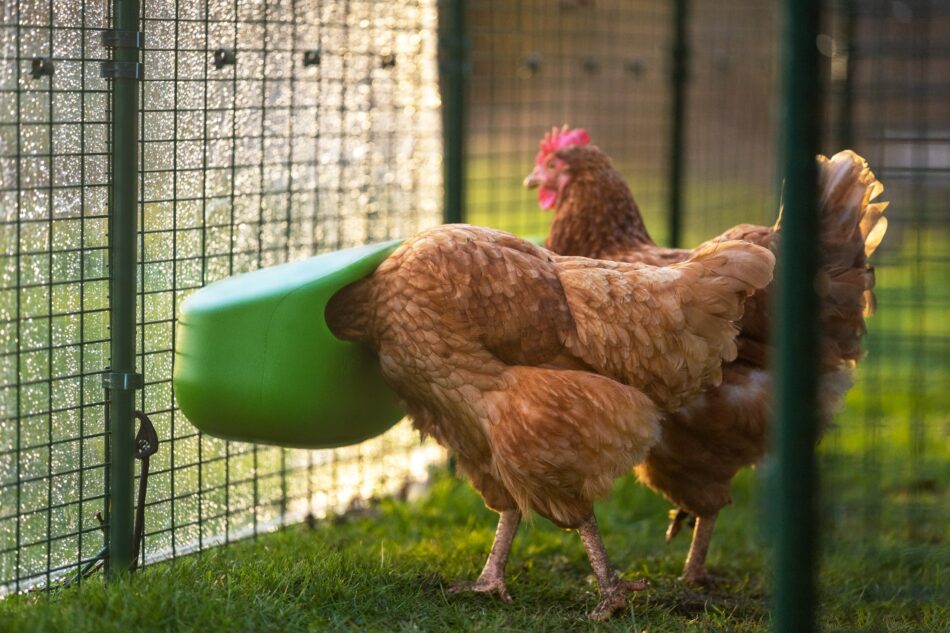
This entry was posted in Chickens

Wondering what the benefits of a chicken tractor are? The term may or may not be familiar to you, but it’s one that chicken keepers across the US are researching more and more. You may also be wondering: what exactly is a chicken tractor?
Chicken tractors are great for adding diversity to your flock and your yard or garden. They also make it possible to move your hens quickly and safely, which is appealing to those that live in areas that experience severe weather events.
Omlet offers easy-to-assemble chicken tractors that are perfect for backyard flocks. Does the ability to move your flock appeal to you? Let’s take a look at chicken tractors, and how they can benefit flock raisers.
What is a chicken tractor?
Chicken tractors are floorless, mobile chicken coops, with or without wheels. The idea began when farmers wanted to raise meat chickens on pasture, but without the risks that free-ranging can bring. The result was the “chicken tractor”, so named because the animals contained within it churn the ground much like a tractor would. There are “tractors” for multiple species of farm animals, such as rabbits, poultry, and pigs. The effect was two-fold: pasture-raised animals produce higher quality meat than those raised in a barn or coop, and areas of dense vegetation could be mowed down by animals inside of the tractor.
This method has practical applications for backyard flock raisers that keep laying hens as well. Fresh grass, vegetation, and insects that hens ingest while foraging outside of their coop offer great nutritional value to their diet. In turn, some of these nutrients pass through to their eggs, making them healthier for you!
Reasons to get a chicken tractor
Aside from adding supplemental nutrition to your flock’s diet, keeping your flock in a chicken tractor has other benefits.
- Chicken tractors are easily moved, allowing you to relocate your coop whenever you’d like
- Mobile chicken coops can be moved in preparation for severe weather, changes in the seasons, or to help with landscaping
- Relocate your coop easily if you move, or if you have a small yard that would benefit from rotating your hens’ area
Chicken tractors for flocks of laying hens can be very practical, depending on your routine and space. A chicken tractor from Omlet can also be attached to chicken runs later for a more permanent chicken coop setup, making them a flexible and customizable option.
What’s the best chicken tractor for my hens?
Omlet chicken tractors come in different sizes and configurations. The Eglu Cube Chicken Coop configured as a mobile coop has an attached run with added wheels and handles. Our largest coop, the Eglu Cube is the best choice for larger flocks of 4 hens or more. Despite its ample size, the Eglu Cube chicken tractor can be moved easily by just one person. The raised coop offers extra pecking space below, as well as a shady area for your hens to get relief from the sun.
The Eglu Go Up Chicken Coop is a more compact version of the Eglu Cube. Best for flocks of up to 4 hens, the Eglu Go Up offers elevation to make coop cleaning and egg collecting easy. This smaller chicken tractor is perfect for children to help clean and move around.
Lastly, the Eglu Go Chicken Coop is a ground-level chicken coop that can be configured with handles and wheels to be converted into a chicken tractor. Some breeds of chickens (or individual hens) prefer roosting on the ground, making the Eglu Go an ideal choice.
What to expect the first time keeping chickens
- Lean into the first-time chicken-keeping angle, as many people looking at the benefits of a chicken tractor will be in the research phase before taking the leap.
- Consider presenting the types of thing people should expect from their first flock, and what they should have to be prepared for them.
How often to move your mobile coop
When to move your chicken tractor depends on a few factors. Chickens don’t just eat the bugs found in the grass – they actually eat the grass as well. The best method for deciding when to relocate your chicken coop is by observing the grass. Once your hens have mowed it down, it’s time to move to a new patch. It’s entirely possible to have your hens mow your entire yard by rotating them in a pattern.
It’s also helpful to move your mobile chicken coop to sunnier areas in the winter, or to shady areas in the summer. In the case of severe weather, a chicken tractor can also be moved quickly to a secondary shelter, or out from under trees to avoid potential falling limbs.
Can I move my tractor with the chickens inside?
Keeping your chickens inside your chicken tractor while moving it is dependent on their personalities and your terrain. Some hens may be content to go along for the ride when being relocated, while others may be alarmed. If your yard is relatively flat, the gap created along the bottom from engaging the wheels of the chicken tractor should not be large enough for hens to escape through. However, a panicked hen may attempt to squeeze through small spaces.
Test your flock’s reaction and build their confidence by moving your chicken tractor by just a few inches at a time. After some practice, you’ll likely be able to keep your hens inside while your mobile coop is being relocated. If your property isn’t flat, or if your flock is upset by being moved around, you’ll need to relocate your hens to a chicken pen during moves.
Tips to make your flock love their chicken tractor
Chicken tractors can be customized just like their stationary counterparts. Chicken toys and accessories or a chicken swing are perfect for adding height and enrichment to your hens’ environment. Simply add these entertaining pieces to the attached run of your chicken tractor, and enjoy watching your hens peck the ground and play in their personalized space.
Freedom with Omlet
Omlet believes in letting chickens live their best, most natural lives while being protected. Our chicken tractors have all of the features of our stationary coops, with the added convenience of being mobile. Flexibility in chicken keeping has never been easier than with Omlet’s mobile chicken coops. Combine our chicken tractor with chicken fencing to create custom boundaries for your chickens, and add chicken treats to your routine to deepen the bond between you and your flock.
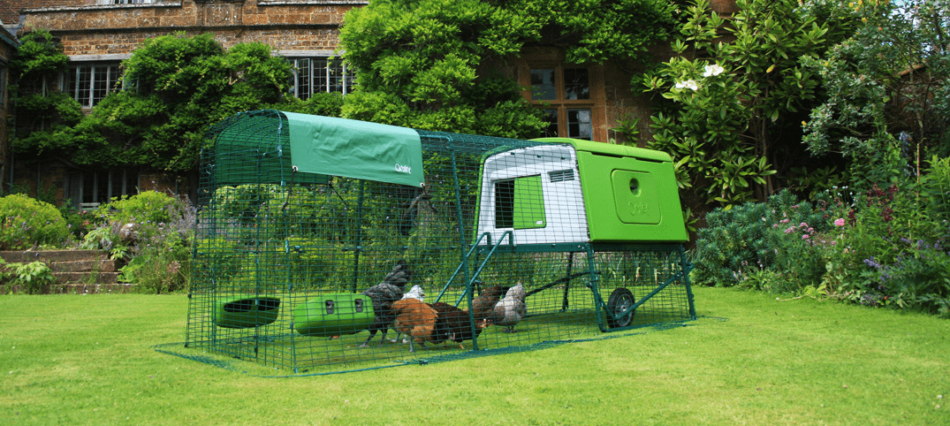
This entry was posted in Chickens
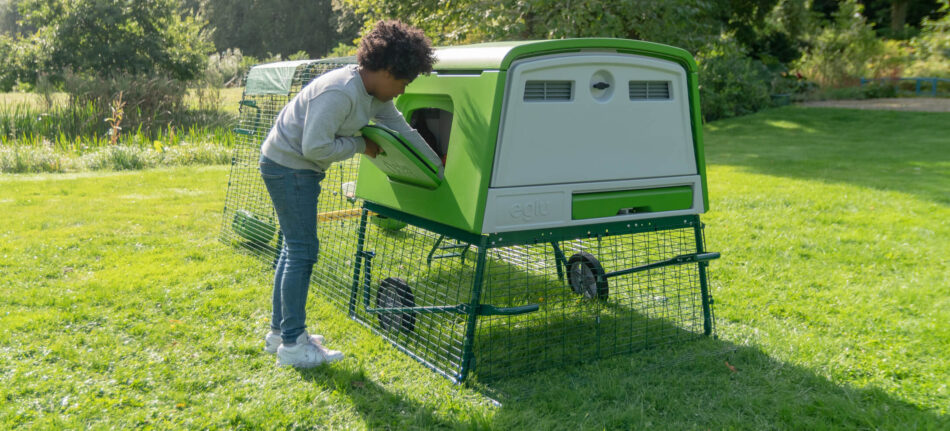
The best chicken coop is safe, functional, and comfortable for the hens they house, and easy to clean and maintain for their keepers. In short, the best chicken coops are those that bring joy to flock raisers, and ensure their inhabitants are healthy and safe.
But not all chicken coops are created equally. A high-quality coop may require some investment upfront, but will more than make up for it in the long run. At Omlet, we are simplifying the process down to comparison of quality and features, so you’ll be ready to make the right choice.
How to choose your chicken coop
When searching for the best chicken coop, size matters! First and foremost, you’ll want to decide on what size flock you want to keep to determine which chicken coop will meet your needs. For most chicken keepers, a small number usually evolves into more hens than originally planned (a phenomenon known as “chicken math” to those in the poultry world). By getting the largest coop within your budget, you’ll allow room for a potentially growing flock.
We advise you to check the zoning laws and ordinances in your State before purchasing chickens or looking to expand your flock.
Do I need a run?
Next, you’ll need to decide if you need a chicken run attached to your coop. Providing the most outdoor space possible will make your hens the happiest, regardless of your flock size. Runs that come standard with some coops usually aren’t large enough to provide that free-range feeling. But, not all chicken keepers are able to give their hens free rein of their yards either. Attaching a walk in chicken run to your chicken coop will offer plenty of space for your flock to forage and flourish.
Material
Finally, you’ll want to fully weigh the pros and cons of the material of your chickens’ coop. Traditionally, chicken coops are made out of wood, but many chicken keepers are making the switch to plastic chicken coops. There are many reasons for this, but one of the biggest deciding factors influencing this change is the longevity of plastic over wood.
What is the best chicken coop made from? Plastic vs Wooden
Plastic chicken coops, such as those designed by Omlet, do not require seasonal maintenance. The advantages of plastic over wooden coops are staggering, and can save chicken keepers countless hours and dollars over the years.
The advantages of plastic coops include:
Plastic coops also offer a less-hospitable environment for mites, which thrive in wooden coops. Mites take shelter in the grooves and crevices of wood, and flourish in damp, porous surfaces. Regularly cleaning a plastic chicken coop is the best and easiest way to keep mites at bay.
One of the biggest mistakes new chicken keepers make is not factoring in the maintenance required to keep wooden chicken coops safe and functional for their flocks. Even weather-treated wood warps and rots in the elements over time, which causes the structural integrity of the coop to be compromised. Roofs need replacing, paint needs reapplications, and the drafts resulting from shifting or settling require attention. Depending on the amount invested in the original coop, sometimes it’s more cost-effective to replace the entire coop rather than to mend seasonal issues.
Best chicken coop for large flocks (5 – 10 chickens)
Omlet’s largest chicken coop, the Eglu Cube can accommodate flocks of up to 10 small breed hens. Larger breeds of hens or larger flocks thrive in this size coop because of the:
- Spacious roosting area inside
- Partitioned nesting area
- Shaded area beneath the coop.
- Wide roosting rack to accommodate hens of all sizes
- Twin-wall insulation
- Draft-free ventilation
- Heavy-duty plastic construction
Most hens don’t mind sharing a nest with other hens, but after the 5th or 6th visitor to the same nesting spot, hens may seek out alternate laying locations. The expanded nesting area of the Eglu Cube factors in picky hens, giving them ample space to fluff up a new spot to lay in.
WHAT DO OUR AMBASSADORS SAY?
The Omlet Ambassadors are customers turned product and chicken keeping experts.
They can answer questions on the Eglu Cube and share their experiences of their Omlet journey and how they use our coops with their hens. You can find an ambassador near you to get the answers that matter most to you and your flock.
Best chicken coops for smaller flocks (2 – 4 chickens)
Perhaps you live in an area that limits the number of chickens you can keep, Or, maybe you’re just getting started with chickens and are hesitant to get too many hens at once. If so, Omlet has the best chicken coops for you too!
The Eglu Go Chicken Coop is a compact, ground-level coop that is the perfect size for small flocks of 4 hens or less. This coop is a great option for:
- Small-breed hens
- Chicks 12 weeks or older
- Chickens that prefer to roost on the ground.
- Secondary hen house and nesting area for growing flocks or injured hens
If an elevated coop still appeals to you, the Eglu Go Up Coop is the raised version of the Eglu Go. The added height allows for easier coop cleaning and egg collecting, and offers additional space beneath the coop.
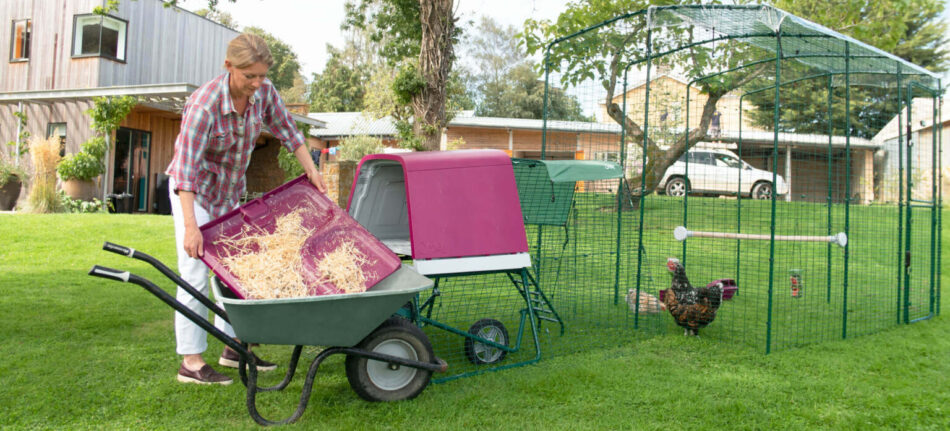
Best portable coop
Chicken tractors offer the freedom of flexibility for chicken keepers and their flocks. Chicken tractors are portable chicken coops that can be:
- Relocated easily for chickens to have access to fresh pecking grounds
- Mobile chicken coops that can be moved quickly and easily
- Beneficial to those in areas that experience severe weather events
Omlet’s chicken tractors can be moved effortlessly by one person. Simply engage the wheels and use the handles to roll your large flock’s home to a different location. Once the coop is in place, disengage the wheels and watch as your flock gets busy pecking around in their fresh patch of vegetation.
Just because they’re mobile doesn’t mean we’ve skimped on features – Omlet’s portable chicken coops have the same ingenious features as their stationary counterparts. Broad roosting racks, designated nesting areas, and heavy-duty construction are core components of all of our chicken tractors.
Best coop with attached run
An attached run offers additional space for chickens that may not have a safe area outside of their coop. All Omlet chicken coops can be customized with attached runs of varying lengths, which can also be moved along with mobile coops. Large flocks can enjoy up to 12 feet of attached run space when combined with the Eglu Cube.
However, the best chicken coop option that offers the most space for your flock is a walk in chicken run. Connection kits make integrating your Omlet coop or attached run quick and easy, or simply place the entire coop within the walk in run. Omlet walk in runs make it easier than ever to spend time with your flock, and maximize your chickens’ outdoor space.
Best budget coop
In terms of price, the Eglu Go Coop is the most budget-friendly chicken coop from Omlet. When compared to similar sized wooden chicken coops, its price point is slightly higher. However, cheaper, wooden coops will need routine maintenance, up to and including full replacement over time, whereas the Eglu Go does not require the same upkeep.
It’s also worth noting the quality of the attached runs. Wooden chicken coops weaken in the elements, causing chicken wire to come loose. Most wooden chicken coops use staples to affix mesh to the run, but when the wood rots, these staples are easily pulled out – leaving your chickens vulnerable to predators. Omlet’s attached wire runs are heavy-duty, and are held together by our innovative clips that won’t rot. Depending on the method of galvanization, chicken wire can bend and break under force from predators, giving them access to your hens and their eggs.
Easiest coop to clean
Keeping your Omlet chicken coop clean is immensely easier than cleaning a wooden coop. All components of the interior of Eglu chicken coops can be removed and thoroughly cleaned in minutes, and the entire coop can be pressure washed for a deep clean. Omlet’s best chicken coops are portable and can be moved closer to designated cleaning areas for even easier access.
Routine cleaning and disinfecting is important for your hens’ health. Mites and other parasites that commonly seek out chickens live in damp, porous surfaces that are left alone. Wooden chicken coops are often breeding grounds for mites if not treated with insecticides– which in turn can irritate your hens. The best method to control mites is preventing them from taking hold. Plastic coops are not ideal environments for parasites, and daily cleaning will virtually eliminate their presence.
Best hen house for collecting eggs
A raised chicken coop is the easiest type of coop to gather eggs from. The Eglu Cube has a separate door that opens to the nesting area, giving you quick and easy access to fresh eggs. Children especially will enjoy how easy it is for them to participate in this favorite activity among chicken keepers.
Eggs can stay in the chicken coop for several days and still be fresh, but collecting eggs daily is always the best practice. Daily egg collection removes temptation for predators, gives your hens room to lay the following day, and gives you a chance to evaluate your hens’ health. And, as you’ll soon learn, there’s nothing quite like collecting a still-warm egg from the nesting box, laid by one of your own hens!
Chicken coop essentials
Once you’ve found the best chicken coop for your hens, there are optional accessories you can add to make your backyard keeping experience even more enjoyable – for both you and your flock:
Award-winning chicken coops from Omlet
Omlet has been in the business of creating the best chicken coops on the market for decades. Our hen houses, chicken pens, and line of chicken toys add joy to the lives of flock raisers, helping them keep their chickens happy and healthy. If you have questions about our chicken products, feel free to reach out to one of our experts at Omlet, and we would be happy to assist you in beginning your chicken-keeping journey.
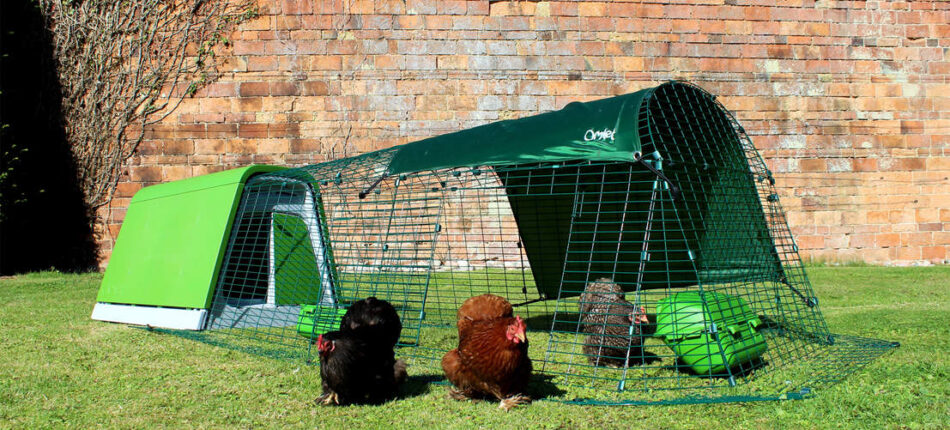
This entry was posted in Chickens
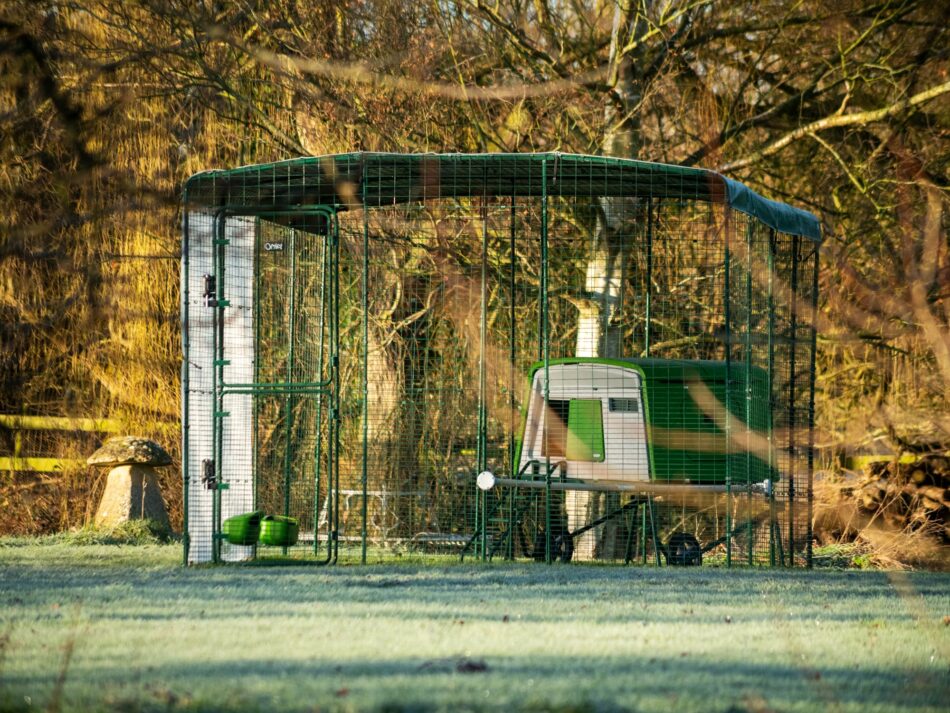
Chicken run covers are an essential part of keeping your flock healthy and happy. They offer shade in summer, act as an umbrella during downpours, and keep debris from falling through the top of the run. In rain or shine, Omlet’s line of chicken run covers offers a wide range of protection for your hens.
What are run covers?
Outdoor chicken run covers are specially crafted tarps that go over the top of a chicken run. They offer shade from the sun, keep rain from falling on your hens, and act as a barrier from falling debris. This is especially important in preventing avian flu in chickens, as the virus is shed through the droppings of birds that fly over your flock.
Our covers differ from traditional tarps in that they are designed to be weatherproof, long-lasting, and specific to each size of our runs. Omlet’s Walk In Chicken Runs have gable-shaped roofs specially designed to support our covers and prevent water from accumulating on them.
Omlet run covers come in two different options: heavy duty and clear. Both are made from UV-resistant, waterproof materials, but our heavy duty covers block more sunlight to offer shade during warm weather. The clear covers are ideal for the wintertime when natural warmth from the sun is in short supply.
Which run cover do I need?
Choosing the right cover for your run depends on your location and chicken coop position. If your coop and run are in a shaded area, then a clear cover for winter months will offer protection and sunlight when shade trees lose their leaves. If your coop and run are out in full sunlight, a heavy duty cover will provide shade and shelter from storms.
Similarly, chicken keepers in warm climates will benefit from heavy duty covers that allow as little sunlight through as possible. This reduces the number of UV rays shining through on your flock, and provides shade from the sun. Colder climate hens will appreciate the additional sunlight that clear covers allow in, while keeping the snow and ice out.
We also offer combination covers that include protection for both cold and warm weather. These can be positioned on top or on the sides of the run to adjust the amount of light allowed in. Positioning a cover down the side of the run also provides a wind break – an attractive option for flocks in windy areas.
Omlet chicken run covers are custom-made for each size run that we offer. From attached Eglu runs to larger walk in runs, we have a cover for every set up. Mix and match your covers if you have your Eglu’s run attached to a walk in run for a wider spectrum of coverage.
What else do I need for my chicken run?
Once your run is covered, accessories can be added for your flock to enjoy in any weather. A PoleTree Customizable Chicken Perch is a great addition to a walk in chicken run, as it offers multiple levels of perching space. The PoleTree is completely customizable to your hens and their space, and can be outfitted with individual and connecting perches, as well as treat dishes. Pendant Peck Toys offer fun at ground level, and keep the run nice and tidy – reducing visits from rodents. A Chicken Swing is another favorite among our customers and their hens, and offers entertainment all around!
Does my run need bedding?
Even with a run cover, your chickens’ run will need bedding of some sort. Unless you have a chicken tractor to move around your yard, your chickens will make quick work of any grass in their run. Without grass, your chickens’ run will turn into a muddy mess in a hurry. A covered run greatly reduces the amount of rain that will make its way into the run, but heavy storms can blow rain in from multiple directions.
The most common choices for the floor of a chicken run are:
- Wood chips
- Sand
- Pine shavings
- Straw
- Gravel
You can use a combination of substrates depending on your soil’s ability to drain. A covered run will keep bedding fresher longer – especially natural flooring media such as shavings or straw.
More weather-resistant products from Omlet
Omlet understands that life is full of extreme variables. We’ve created accessories that enhance our products’ safety and comfort measures. Our sophisticated Eglu Cube Chicken Coop has superior insulation to keep your flock warm in the winter and cool in the summer. But by adding Temperature Protection to our coops, you’ll double down on the insulating properties to keep your chickens comfortable in any climate.
The most rewarding feeling as a chicken keeper is knowing your flock is as comfortable and safe as possible. Omlet creates products that bring chickens and their keepers closer than ever – improving their collective happiness in the process.
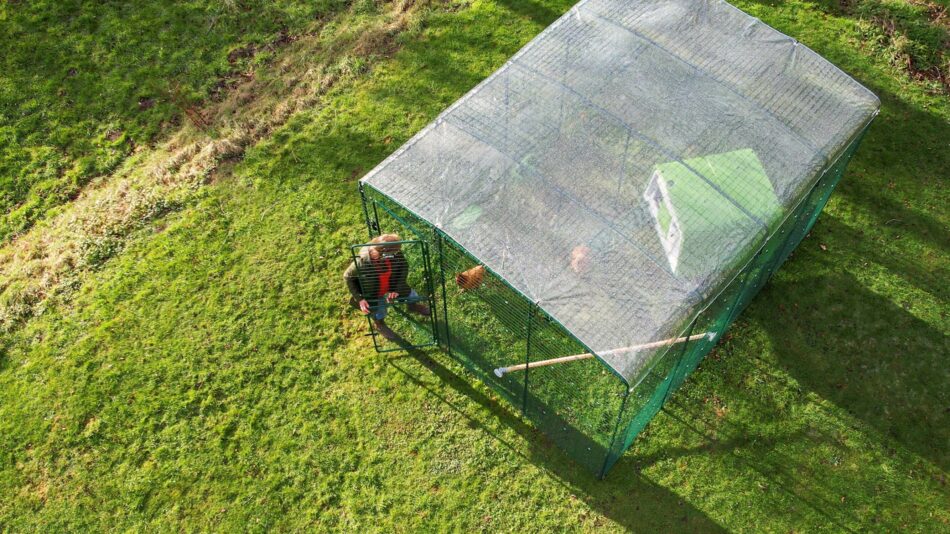
This entry was posted in Chickens
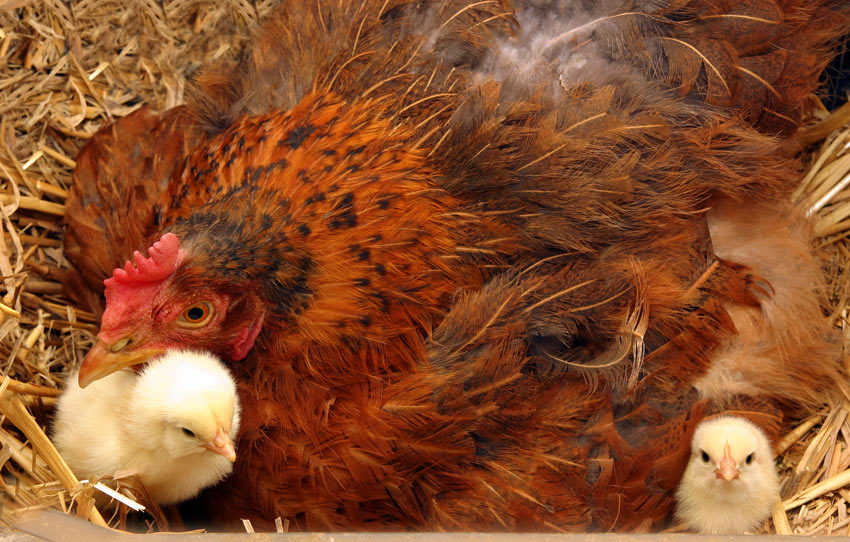
Wondering when your brooder-raised chicks can go outside? Raising hens from chicks is an exciting endeavor, but deciding when it’s safe to transition them to the outside world can seem daunting. As with most plans, timing is key! We’ve taken the guesswork out of transitioning chicks from a brooder and into their forever coop and run. With the help of a comfortable chicken coop and the knowledge to follow, you’ll gain the confidence to know when and how to safely move your chicks outside.
At what age is it safe for chicks to go outside?
If you’ve had your chicks since they hatched, or got them shortly after, you’ll recall how soft and fluffy (and adorable) they looked. The “downy” feathers that give a chick their fuzzy appearance don’t stick around for long. You’ll soon notice your once fluffy chicks start to look a bit bedraggled. This perfectly normal (while unsightly) phenomenon is simply the process of your chicks’ adult feathers growing in. In general, you should see these adult feathers start to peek through sometime between 7 and 14 days old. There are multiple factors that will determine how quickly a chick grows their adult feathers such as:
- Breed
- Diet
- Temperature
- Care
Once you’ve noticed these adult feathers mottling your chicks’ fluff, it’s time to start slowly decreasing the temperature of the brooder. Aim to reduce their heat by 5℉ each week until the brooder and the ambient temperature are the same. This gradual decrease in temperature will further aid in their transition to life outside.
By the time your chicks reach 5 weeks of age, they’ve officially entered their “teenage stage.” They may sport a convincing set of adult feathers, but like most teenagers, are not quite mature enough for the outside world! Once your “teenage” chicks reach 6-8 weeks of age, it’s time to consider letting them fly the brooder in favor of some supervised outdoor excursions.
3 essential factors to consider when taking chicks outside
To help you determine if your chicks are ready to spend any amount of time outdoors, ask yourself:
- Do my chicks have all of their adult feathers?
- Is the weather above 60℉?
- Will they have a fully enclosed space?
When your chicks are fully clothed in their adult feathers, they can withstand temperatures as low as 60℉. Sunny days are always best for outings with your chicks, and it’s important that they stay dry in order to help them regulate their temperatures. A fully enclosed chicken run is essential for outdoor visits – especially if you’re unable to stay with them the entire time.
Temperature and climate considerations
Timing is key when moving your chicks from their brooder to their coop and run, but if your chicks are at least 6-8 weeks old, they’ll be able to tolerate cooler temperature dips. If you have a chicken tractor, you may want to move it around to follow the sun to help your chicks transition from artificial heat to natural heat. And, if your area experiences frequent weather fluctuations in the colder months, you can add extreme weather protection to your chicks’ coop to ensure they stay cozy overnight when they are most vulnerable.
If you’re letting your chicks out during warmer months, a raised chicken coop offers additional shelter and shade. Like adult chickens, chicks can become overheated in warm climates. Be sure to have plenty of fresh water available, and use chicken run covers to provide ample shaded areas.
Predator protection for chicks
Once your chicks are spending large stretches of time outside, it’s not always feasible to monitor them. A safe chicken coop and predator-resistant walk in chicken run are essential not only for housing hens, but for introducing chicks to the outdoors as well. Chicken predators are mainly active at night, but there are those that would not pass up an opportunity for chicks during daylight hours.
It should be noted that chicks are particularly vulnerable to predators such as snakes and raccoons that can fit themselves or their paws through the openings of wire runs. For extra security, wrap the bottom 4 feet of your chicks’ outdoor run in hardware cloth to help protect against these predators.
Consider giving your chicks plenty of places to “hide” if they get overstimulated. Simple structures such as upturned cardboard boxes with entrances cut into them, or other DIY hides are sufficient. And while your chicks might not be big enough to fully utilize chicken perches, Omlet’s Freestanding Chicken Perch has easy height adjustable perches to give your chicks an opportunity to practice their climbing skills.
Mother hens
Some chicks are hatched and raised naturally under their mothers. Hens can go “broody” (sitting on a clutch of eggs to hatch) any time of the year, but will usually attempt to hatch eggs in the spring. If your hen is broody in the winter, it’s best to discourage her by collecting eggs daily, as chicks hatched in the winter will have a harder time than those hatched in the warmer months. If your location experiences mild winters, hens can successfully keep chicks warm in below-freezing temperatures, but will need to be monitored to ensure that the chicks aren’t being left unattended for too long when the hen goes to eat or drink.
Nature will take its course when chicks are left to be raised by a hen. Hens will provide warmth to their chicks even after they hatch, making them the “brooder.” Good mother hens instinctively know how long their chicks can withstand the absence of heat, and will help their young adjust to the ambient temperature.
If your hen hatched chicks in an elevated chicken coop, consider moving both the hen and chicks to a ground-level chicken coop to avoid chicks accidentally falling while following their mother. Alternatively, you can remove the hatched chicks from the hen once they are dry and place them in a brooder.
Taking chicks outside during the day
If you’ve been decreasing the temperature of the brooder, your chicks should be comfortable outside in temperatures as low as 60℉ by the time they are 6-8 weeks old. For successful outdoor excursions with your chicks, choose days that are sunny and warm. Start with short visits to your chicken pen and let them hop and scratch around.
Every chick is different, but expect to see hesitation or uncertainty from your chicks at first. The feeling of grass under their feet is much different from the straw, shavings, or flooring of their brooder. The outdoors hold many sights, sounds and smells that are foreign to brooder-raised chicks, so start with short visits to avoid overstimulating them. Aim for 10-15 minutes once or twice a day to help build your chicks’ confidence. Be sure to stay with your chicks during these first few visits to see how they react to their surroundings.
After several days of short visits, increase outside time by 10-15 minutes every couple of days, keeping the weather in mind. Before long, your chicks will be spending many daylight hours getting used to their permanent home. If you haven’t already, now is the perfect time to start letting your chicks out in their coop and run during their outdoor time.
Checklist for permanently moving chicks outside
Your chicks are fully feathered, have successfully completed outdoor trips to their new home, and are thriving. It’s time to make the move permanent! Make sure the following are met before moving your chicks outside full-time:
- A safe chicken coop that your chicks are comfortable accessing
- An attached chicken run reinforced with additional predator-resistant measures
- Feeders and waterers placed at appropriate heights for your chicks
- Outdoor temperatures of 60℉ or higher, even overnight
- Your chicks are at least 6-8 weeks old
If you are moving your chicks to an Eglu chicken coop, the recommended age is 12 weeks old. This gives them ample time to grow into a size that is appropriate for the design of Omlet coops. Roosting racks and coop ladders may pose a challenge to chicks under 12 weeks of age, and the wire spacing of the run was designed with larger chicks in mind.
Can chicks be outside with other hens?
If your chicks will be joining other hens, follow the same steps as you would when introducing new chickens to your flock. Quarantine periods need not apply to chicks you’ve raised yourself in a brooder, as you would see signs of illness during that time. However, you’ll want to introduce chicks to their future flock-mates slowly to minimize the risk of injuries. A chicken pen placed inside or next to your existing flock will allow your chicks to visit your other hens safely.
As always, hens have to establish a pecking order, regardless of how many times they’ve seen each other through a barrier. Always monitor the first encounter when introducing new members to a flock. Quickly remove any chicks that hens appear to pick on, and consider housing them or any aggressive hens separately until your chicks are bigger.
Winter considerations for letting chicks outside
Most chicken keepers will agree that spring and early summer are the best months to move their chicks outside. However, with some climates experiencing dreadful cold for over half of the year, it can make spring chick-raising slightly more difficult. In these situations, it’s best to keep your chicks in their brooder for as long as possible – ideally, until they are 12-16 weeks old. If your chicks are too large to stay in the brooder for that long, be sure to take extra precautions against the cold. Prepare your chicks’ coop and run for the winter as you normally would for adult hens, trusting that your Eglu keeps your chickens warm. Additional weather protection for your chicken coop can be added to provide extra insulation.
Are my chicks too cold?
The same signs of chickens being too cold apply to chicks. Check-in on your chicks routinely and monitor for any signs of them getting too chilly, such as:
- Lethargy
- Huddling together
- Standing with one foot off of the ground
- Discoloration of combs, wattles, or feet
If you notice any of these in your chicks during cold weather, bring them inside promptly. Do not warm them up too quickly, as this can cause them to go into shock. Only use a heat lamp if their inside area is in a drafty space such as a garage or barn. Indoor temperatures above 65℉ will be adequate to slowly warm up any overly-chilled chicks. Keep them inside until they are eating and drinking normally, and plan to let them back out when the outdoor temperatures stabilize.
When chicks should not go outside
There are some circumstances where chicks should not be transitioned outdoors. These include:
- If your chicks are less than 6 weeks old
- Sustained temperatures below freezing if your chicks are less than 12 weeks old
- During heavy rains or extreme weather
- If your chicks cannot easily access their coop
Always check your weather forecast to get an idea of temperatures and precipitation for the week you plan to permanently transition your chicks outdoors. If heavy rains are expected, or any other significant weather events are, postpone until conditions improve. Wet chicks, just like their adult counterparts, have a hard time regulating their body temperatures when they’re wet.
Some chicks get the hang of a chicken coop ladder quickly, while others may struggle to perfect this technique. If you notice that some of your chicks are unable to use a ladder, create a ramp to lay on top of the ladder rungs. Once they’ve gotten the hang of using their growing feet, you can remove the ramp.
Lastly, consider avian flu and its prevalence in your area. Chicks are just as much at risk for contracting avian flu as adult hens, but by using waterproof chicken run tarps to prevent droppings from wild birds, you can greatly minimize that risk.
Omlet’s award-winning chicken care products
Omlet aims to help you succeed in all of your chicken-keeping endeavors, including supporting you in your journey of raising hens from chicks. Large chicken coops help accommodate your growing flock, and mobile chicken coops help move your chicks even closer to you for supervision, or to get them closer to their future flock-mates. Our hen houses make excellent first-time homes for chicks, keeping them safe and comfortable in all climates.

This entry was posted in Chickens
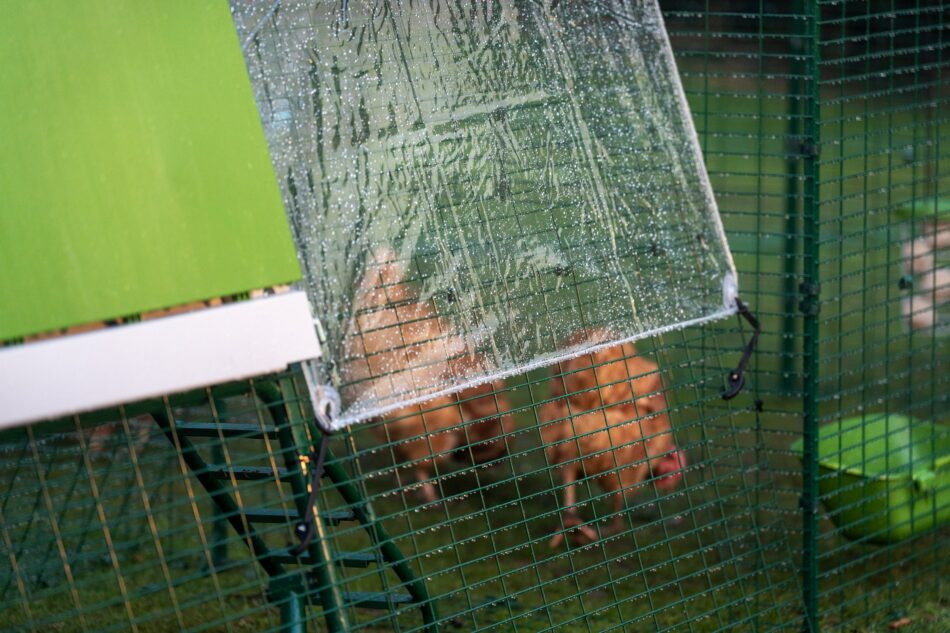 Have you ever wondered if your chickens like the rain? Hens don’t put on rain hats and boots to weather a spring shower, but some chickens are more willing to stay out in the precipitation than others. Whether it be rain showers or all-out downpours, at some point all chicken keepers will have to help their hens through wet weather. Thankfully, Omlet has the products that keep chickens safe – whatever the weather.
Have you ever wondered if your chickens like the rain? Hens don’t put on rain hats and boots to weather a spring shower, but some chickens are more willing to stay out in the precipitation than others. Whether it be rain showers or all-out downpours, at some point all chicken keepers will have to help their hens through wet weather. Thankfully, Omlet has the products that keep chickens safe – whatever the weather.
Rain and chicken safety
You may have some hens that are more than happy to hang out in a rain shower, or peck through the puddles in the aftermath. But, some chickens may avoid precipitation at all costs. As a general rule, hens will seek shelter once a sprinkle becomes more of a drenching experience than an enjoyable shower.
Rain isn’t necessarily dangerous for your hens so long as the temperatures are moderate. The most dangerous time for a chicken to become wet is during cold weather, as hens need to be able to fluff their feathers up to trap air around their bodies as insulation. If they’re wet, feathers will be heavy and lay flat, which keeps a hen’s feathers from doing their job.
Our new Walk In Chicken Run Rain Covers encompass the entire top of your flock’s run with a waterproof barrier to help keep the rain and snow out. No walk in run? No problem – our new Eglu Go Up Rain Covers will keep attached runs free from moisture as well. Keeping precipitation from falling directly on your hens is the best way to help them stay warm and dry.
Other dangers of rain for chickens
Aside from rain during cold weather, too much moisture can spell other trouble for chickens. Muddy conditions in the run opens your flock’s feet to bacteria and fungal infections, and creates unsanitary conditions. And, hens that stay wet or in damp houses for extended periods of time can develop upper respiratory infections. These primarily develop from mold or mildew growing in their coop, which is why a chicken coop that will not absorb moisture is so important to your hens’ health.
Puddles may be fun for kids to splash in, but chickens may drink from rainwater that has collected on the floor of their run. Muddy puddles can contain harmful bacteria and are not ideal for your flock to drink from. In addition to waterproof chicken run covers, bedding should be added to the floor of any runs that don’t have enough grass to prevent the ground from becoming excessively muddy.

Do any chicken breeds like the rain?
Some breeds of chickens struggle more than others in damp weather. For example, Silkie chickens have special feathers that do not repel water, so they can quickly become soaked through to their skin. Polish chickens are another breed that does not do well in wet weather, as they have loosely grouped feathers that do not keep them dry. Other breeds, such as Rhode Island Reds have tightly grouped feathers that help repel rainwater. Other hardy breeds such as Plymouth Rocks and Australorps have better tolerance in extreme temperatures, making them more resilient in damp conditions.
Are chicken feathers waterproof?
A chicken’s feathers are weather resistant, but not weatherproof. The tighter the feather grouping, the more weather resistant a hen’s plumage is. Once even tightly grouped feathers become saturated, water begins to seep through to a hen’s skin and there it begins to affect body temperature. Wet feathers are heavy, so chickens can’t fully fluff themselves in order to dry off once their skin becomes wet. In the wintertime, this can quickly lead to hypothermia. Being a wet hen in summer months is more of a nuisance than a danger, but can still lead to discomfort.
Most hens are aware of their limitations, and you’ll see most head for shelter when they feel they are getting too saturated. However, sometimes hens get caught out in a downpour. If the weather is below 60℉, bring soggy hens inside and towel them dry, being careful to move in the direction of their feathers. Wait for them to dry fully before letting them back outside.
How to keep your flock protected
Our new Eglu Go Up rain covers come in different length options to offer full top-to-bottom coverage, or a ⅔ length to allow a breeze through the bottom third of the run. The walk in chicken run covers now offer full-length coverage in a variety of sizes to fit across the entire top of the run. Continuous coverage means no gaps, dripping, or seams for the wind to grab.
Just like our run covers, Omlet’s chicken products are designed to perform and protect. Going above and beyond their intended purpose, our Eglu Cube has withstood much more than rain! That sort of performance is what we expect from all of the products we invent.
Omlet and your chickens’ home
We strive to create top-quality products that keep your chickens safe and make caring for them enjoyable. Our line of chicken coops are designed to withstand the elements, weather, and anything else life throws at them. Combine our resilient coops with a heavy duty walk in chicken run maximum protection and comfort for your flock – and peace of mind for you.
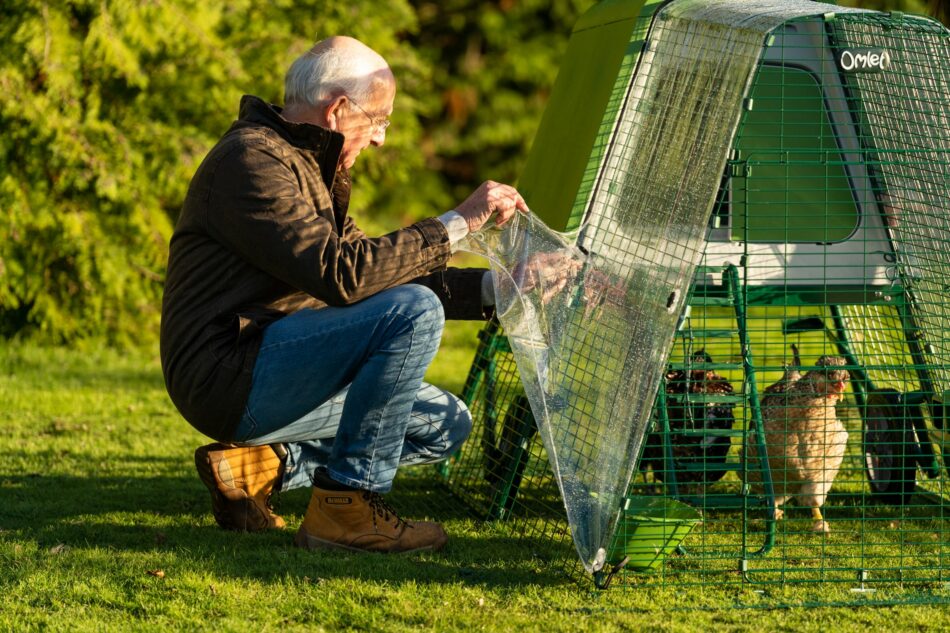
This entry was posted in Chickens
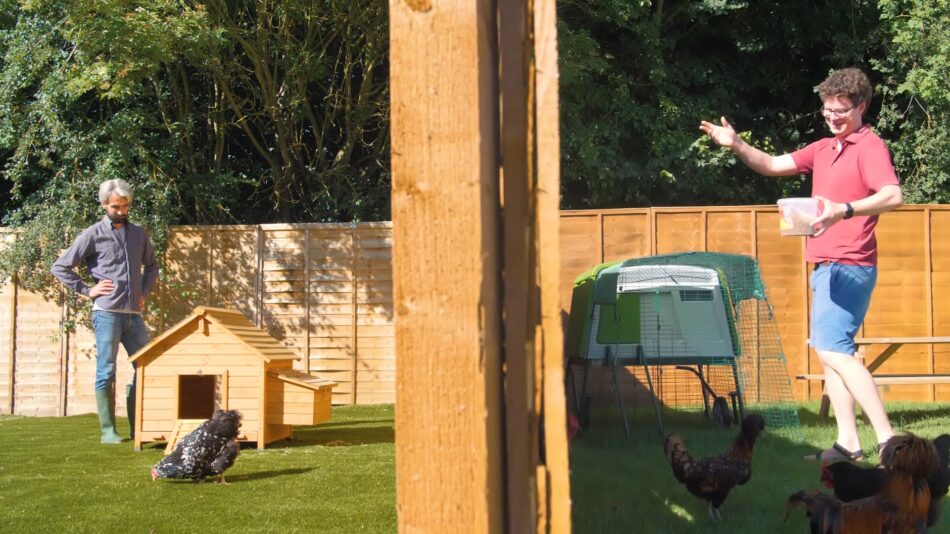
Worried about your chicken coop rotting? It’s a valid concern that all chicken keepers have. Chicken coops are out in the elements, and can take a beating from the weather and predators. Still, chicken keepers rely on their structural integrity to keep their flocks safe – so what happens when a coop starts to rot?
Thankfully, not all chicken coops rot. Wooden coops all eventually succumb to their exposure to the environment, but there’s an alternative option. We invite you to consider: Omlet’s plastic chicken coops.
Why do wooden chicken coops rot?
Wooden chicken coops, by nature, break down over time. No matter how “weather-treated” boards, planks, and roofs may be, they will eventually decompose when exposed to the relentless elements. This is especially true in areas that receive a lot of humidity and severe weather, such as the southern part of the US. A constant battering from rain storms, followed by intense sunshine will leach out the weather protectants that lumber may be treated with. Wind and rain will also loosen or warp shingles on chicken coops, making coops drafty and wet. Once the weather has stripped wood of its protectants, moisture sets in, and the wood begins its rotting process.
Wood that stays damp rots the fastest. Wet wood swells and expands, which allows for more moisture to make its way in. And, when exposed to the sun, swollen wood begins to contract when it dries. Through this process of swelling and contracting, wooden chicken coops begin to lose their shape as the boards or planks warp. You may notice bowed or split wooden components on your chicken coop as a result, which will eventually break or collapse. Different types of wood experience this process at varying speeds, but most commercially bought wooden chicken coops are made from lower-quality wood with a shorter lifespan.
Once the wood of a chicken coop begins to rot, any affected boards will need to be replaced. It’s important to address any rotten pieces of a chicken coop immediately to avoid adverse health effects on your chickens. Rotten wood attracts mites and other parasites that will plague your hens, and mold or mildew is often present in damp wood. These fungi can cause respiratory problems in your chickens, and creates unsanitary conditions for both you and your flock.
How to prevent your chicken coop from rotting
Oftentimes it’s easier to build or purchase a new chicken coop from scratch than to renovate a rotten one. Repairing a rotten chicken coop is costly and time-consuming, and will likely need to be repeated throughout the lifetime of a wooden coop. There are preventative measures you can take to maintain a wooden coop to help improve its longevity, but these too take effort and resources.
Repainting, staining, or weather-treating a wooden chicken coop
To help prevent wood rot, wooden chicken coops can be repainted, stained, or weather-treated regularly – usually on an annual basis. Take great care to select products that are non-toxic to chickens, and allow for ample drying time between coats before allowing your hens back into their house. Natural products such as tung oil can be applied to wooden chicken coops to make them water-resistant, but 100% pure tung oil can be costly.
Keep your coop covered
Another method to help prevent wood rot is to keep your chickens’ coop covered. This could be through the use of a tarp, inside of a structure such as a shed or a barn, or by building a structure over the top. It may seem a bit redundant to cover a chicken coop that is meant to protect your flock from the elements, but shielding a wooden coop from sun and moisture can help preserve its components. This isn’t the most convenient option, and application of water-resistant products will still be needed on occasion to protect the exterior of your coop.
Forgo a wooden coop
By far the easiest option to avoid having to fix a rotten chicken coop is to purchase a plastic chicken coop. Omlet’s Eglu Cube chicken coop is made of heavy-duty plastic that’s weather and waterproof, so there’s no concern over rotting components. Truly a zero-maintenance solution, the Eglu Cube is ready to house a flock of up to 10 small breed hens from the time it’s assembled. Omlet’s design is meant to last a lifetime, which means no breaking down or rotting, and no application of preservatives is required to keep your Eglu Cube sanitary and functional.
Why do plastic coops not rot?
The short answer as to why plastic outlasts wood is: because plastic does not exist in nature, naturally occurring organisms are not effective at breaking it down. Wood exists in nature, so there are bacteria and other living organisms that are equipped to dispose of it. Plastic, on the other hand, has no “natural” foes.
Plastic chicken coops do not rot or lose their shape in the elements and do not require routine maintenance. They’re also much easier to clean, offer a more sanitary environment, and are able to be moved with ease compared to their wooden counterparts.
How to maintain a plastic coop
All Omlet products are designed to last, but you’ll still want to check in on your chickens’ coop routinely for any signs of wear and tear. Usually, any doors or parts that are not aligning properly are the result of the soil beneath the coop shifting, and can easily be corrected by moving the coop by a few inches as needed. Chicken run clips may also come loose during these shifts, and should be checked regularly.
Aside from checking your coop for shifting, you’ll also want to clean your coop regularly to keep it fresh. Even deep cleaning the Eglu Cube takes mere minutes, as compared to several hours of cleaning a wooden chicken coop. A pressure washer or high-powered water hose makes the process go even faster. Simply remove the droppings tray and roosting rack, spray clean, and wipe dry.
Compared to wooden chicken coops, maintaining the Eglu Cube saves countless hours each year. And, a coop that’s so easy to clean and maintain creates a much more sanitary environment for your hens, which cuts down on illness and discomfort brought about by the weather. Keeping chickens has never been easier or more enjoyable than with an Omlet coop.
Omlet and your chickens’ perfect home
A rotting chicken coop is a frustration for chicken keepers that we sought to put an end to. The result is our line of high-quality chicken coops that stand the test of time. Combine your Eglu Cube with a Walk In Chicken Run for the ultimate chicken-keeping experience. And, with accessories such as the PoleTree Customizable Chicken Perch or Caddi Chicken Treat Holder, you’ll be able to foster and enjoy watching your hens fulfill their natural behaviors.

This entry was posted in Chickens

Most chicken keepers have to consider how to keep their chickens safe from coyotes.
Urbanization has encroached on natural coyote territories, increasing the sightings of this predator in residential streets and backyards. Notorious for being some of the most persistent of predators, coyotes will dig, scratch, bite, and push their way into many standard chicken enclosures. They’re also extremely agile and athletic, able to clear fences up to 8 feet tall.
Where are coyotes found?
Coyotes can be found in 49 US states – with Hawaii being the exception. From the southern plains, to mountain regions, and even tropical climates, coyotes thrive in a variety of ecosystems. With such a wide territory, coyotes are one of the most common chicken predators that flock raisers encounter.
Being the intelligent and crafty creatures they are, coyotes have quickly learned that the presence of humans brings meal opportunities. Garbage is tempting to a coyote, but these wiley predators will take advantage of unprotected pets in even urban backyards – with chicken being a favorite among coyotes.
Why coyotes are a danger to chickens & signs of an attack
As a member of the canine family, coyotes have excellent scents of smell and hearing. While you may not always hear or smell your chickens, coyotes certainly do. Chickens make an ideal meal for a coyote due to their mild temperaments and high protein content.
Coyotes will most often try to dig into your chickens’ pen – which is why anti-dig skirting is so vital. Quick tunnels dug right next to the run allow a coyote to squeeze through in a manner of minutes. Anti-dig skirting is attached to the run at a 90° angle, extending out by several inches, helping to prevent this tunneling tactic.
You’ll notice dig marks or the beginnings of a tunnel if a coyote has visited your chickens’ run. You may also notice claw marks on the run and broken or bent chicken wire. Coyote’s footprints resemble those of a medium-sized dog – narrow, padded feet with 4 toes and claws.
Which coop is best to keep my hens safe from coyotes?
Wooden chicken coops are not always strong enough to withstand the advances of a determined coyote. Omlet’s line of heavy-duty plastic chicken coops offer superior predator protection. Predator-resistant setups are essential in keeping your hens as safe as possible from coyotes.
Ensure chickens are secured at night
Coyotes can be either nocturnal (most active at night) or diurnal (most active at dawn and dusk) depending on environmental factors. Most coyotes living close to urban areas will adopt a nocturnal schedule to come out while human residents are asleep. In more rural areas, it’s common to see coyotes roaming around sunrise and sunset.
Omlet’s Autdoor for easy coop security
Depending on your schedule and where you live, you’ll need to make sure your hens are closed safely in their coop during a coyote’s most active hours. An Automatic Chicken Coop Door Opener can be easily installed on a secure Eglu Cube Chicken Coop to follow a routine based on the sun or the clock. The open and close schedules are customizable to fine-tune your flock’s routine. This way, your chickens will be tucked in safely even if you aren’t home to close the coop door – making it one of the many reasons flock-raisers love the Autodoor.
The daylight setting of the Autodoor allows you to set the open and close times based on the amount of sunlight available. There is also an optional one-hour delay for this setting, which is particularly helpful during time changes in fall and spring. The amount of daylight is measured by a sophisticated light sensor on the Autodoor’s control panel, allowing you to adjust open and close times according to the readings.
The Autodoor’s time setting enables you to set specific open and close times. This is particularly useful for those in rural areas that need to keep their hens in the safety of their coop until the sun has fully risen, and that need to tuck them in before dusk.
Make sure the coop is well lit
Along with a predator-resistant chicken coop, you can add external safety features to deter coyotes. Coyotes are sensitive to light, so placing motion-activated lights around the perimeter of your property can help keep them at bay. These lights should not be left on all the time, as coyotes will eventually get used to them. You’ll want the “surprise” factor of motion lights. Some predator-specific motion lights use a strobe pattern or a series of different colored lights to further startle coyotes.
Your chickens will also appreciate a light in their hen house to signal that it’s time for bed. While coyotes will avoid lights, chickens are drawn to illumination once the sun starts to set. The Autodoor has an optional chicken coop light that can be added inside of your coop. The coop light integrates directly into the control panel of the Autodoor, and will turn on 5 minutes before the door is scheduled to close, and will automatically turn off once the Autodoor has closed.
The coop light can also be turned on manually at any time at the press of a button on the control panel, making late-night coop checks quick and easy. The soft glow of the coop light will not startle your hens out of their slumber, and will help bring you peace of mind.
Backyard maintenance
Keep your property free of materials that could be hospitable to coyotes. Fallen trees, dense brush or bushes, and spaces underneath outbuildings make great hiding or sleeping spaces for coyotes. Most coyotes will only use a den when raising their pups, but they will take advantage of cover close to a potential meal.
Coyotes may also be drawn to compost piles or the animals that frequent gardens. Many people who keep chickens also keep a garden, but prey animals such as gophers, moles, mice, and wild rabbits also appreciate your garden. These small animals are also favorites of coyotes, so take care to keep these critters away from your yard. Use garden fencing, sprays, or other deterrents to help keep animals away from your plants, and keep compost in a bin or far away from your chickens’ area.
Keep the coop clean
Small animals are also drawn to leftover food in your chickens’ coop and run. Mice in particular are difficult to keep out of a chicken coop. While they won’t harm your chickens, their movement and noises will draw coyotes in.
A chicken peck toy can help keep scratch off of the bottom of the run, and a Caddi Chicken Treat Holder keeps fresh fruits and vegetables elevated and away from rodents. Remove any uneaten chicken feed at the end of the day and store in an airtight container to help deter both mice and coyotes.
Use an alarm
Another deterrent for coyotes is noise. Being a member of the canine family, coyotes have very sensitive hearing. You can purchase special devices that will emit a high-pitched noise, alarm, or whistle when triggered by movement. Alternatively, if you happen to see a coyote on your property, making as much noise as possible will let them know they’ve been caught in the act!
Be sure to keep your distance from coyotes. Most of the time, these predators will be more afraid of you than you are of them, but hungry or ill coyotes may not scare off easily. If you have a coyote lingering around your home despite efforts to run them off, call your local animal control office.
Omlet and protecting your chickens from predators
At Omlet, we understand the importance of keeping your chickens safe from predators like coyotes. We’ve created products like the Eglu Cube Chicken Coop and Automatic Chicken Coop Door Opener to help chicken keepers all over the world keep their flocks safe without adding extra work. The addition of an Omlet Walk in Chicken Run gives chicken keepers an opportunity to spend time with their hens in a predator-resistant environment, and brings peace of mind while their flocks are out foraging. Chickens and their keepers share a unique bond, and we are committed to protecting and deepening that connection with our line of chicken products.
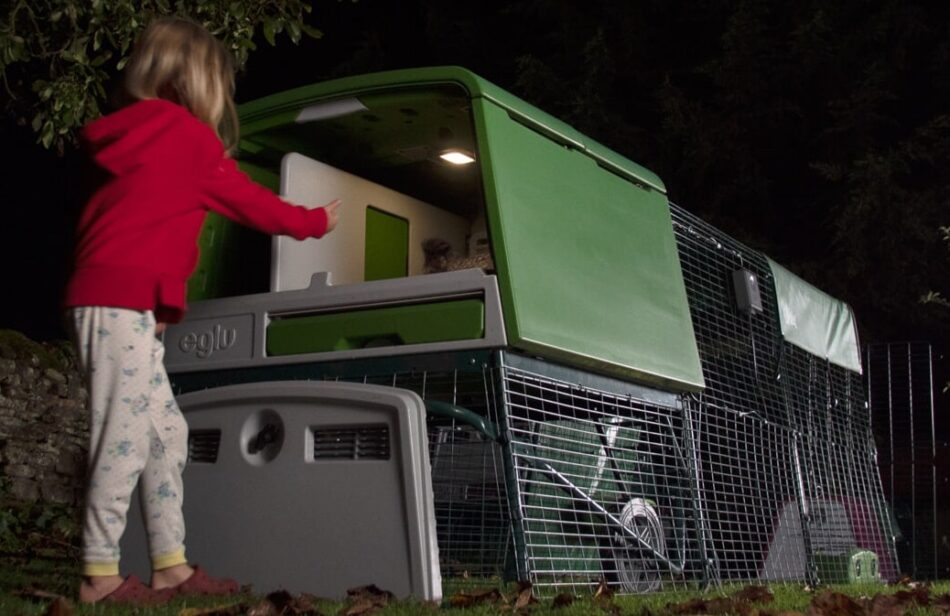
This entry was posted in Chickens
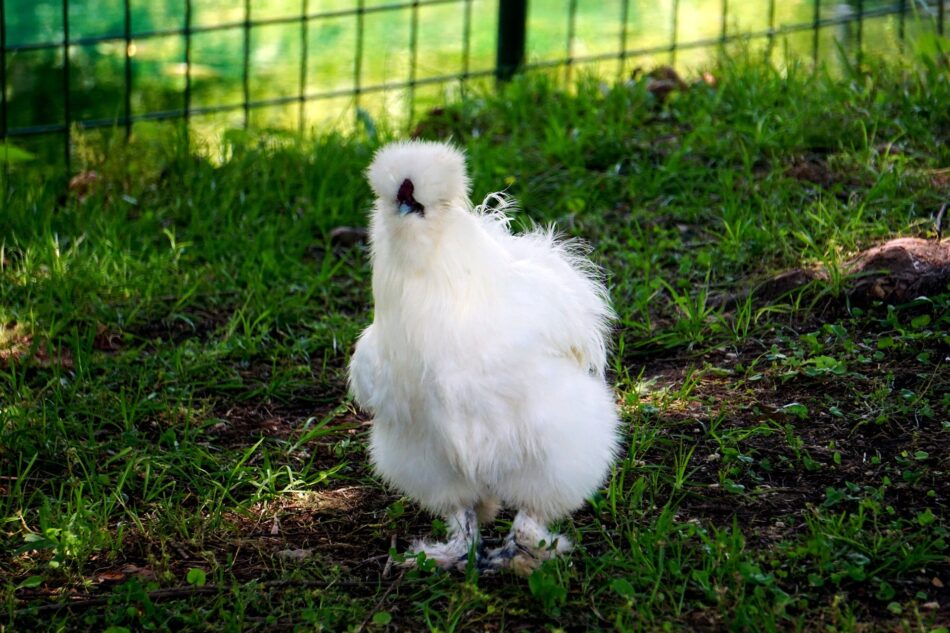
Caring for Silkie chickens is a little different than caring for their regular-feathered counterparts. This breed of chicken, with its very distinctive appearance, has gained popularity among flock raisers everywhere. They’re fluffy, friendly, and fun to watch and interact with. And due to their mild temperaments, are known to be great for children.
Silkie chickens come in a variety of colors, and their fuzzy plumage resembles fur more than feathers. In fact, ancient history describes them as “chickens with hair like a cat.” This ornamental breed isn’t known for egg production, but will lay a modest amount of small eggs per year.
Origin of Silkie chickens
The exact origin of Silkies is unknown, but experts believe they originated somewhere in Asia. Marco Polo described “furry chickens” in his journal during an excursion through China in the 13th century. Some time later, Dutch breeders of Silkies marketed them as a cross between a chicken and a rabbit.
A Silkie is actually a type of “Bantam” chicken. Bantams are a breed of chicken that are much smaller than standard chicken breeds. Other types of Bantams include:
As Marco Polo noted, Silkie feathers have a fur-like appearance. They appear furry rather than feathery as a result of genetics. Chickens with normal feathers have microscopic hooklets that connect each fiber (called “barbs”) on their feathers, creating a rigid and smooth appearance. Silkies have a genetic mutation that creates an absence of these hooklets. Because they lack this feature, a Silkie’s barbs are free to flow every which way, giving them their unique, fluffy appearance.
Are Silkie chickens higher maintenance than other chicken breeds?
While the fluffy appearance of Silkies is adorable, it does pose an issue when it comes to hardiness. Since their feathers are not rigid, Silkies do not have any sort of moisture barrier. Once wet, they will be saturated right down to their skin. This creates very dangerous conditions for any chicken – particularly in cold weather.
Caring for Silkie chickens in winter
Chicken coops with double-wall insulation are essential to keeping Silkies healthy and happy. Weatherproof chicken run covers are also a must-have when caring for Silkies to ensure they stay dry while spending time outside of their coop. As long as Silkies are kept dry in cold weather, they will handle cooler temperatures as well as any other breed. However, when their fluffy, down-like feathers become wet, it will take a Silkie a long time to dry, as they cannot lift their non-rigid feathers away from their skin. A wet Silkie should be placed in a warm coop right away.
Caring for Silkies in hot weather
Silkies also struggle more in the heat than other breeds. This is due to their dense plumage and reduced eyesight from their walnut-shaped comb and feathers around their face. Poorer eyesight makes finding shade and water more difficult. Place multiple chicken waterers around the run to help your Silkies in warmer weather, and provide plenty of shade in their run to help your hens through a hot summer.
How to groom Silkie chickens
While it may be tempting to groom your Silkie, their fluff still consists of feathers – not fur. They will preen and dust bathe themselves just as any other hen would, so extra grooming is usually not necessary. If your Silkie gets extremely muddy, a gentle bath during warmer weather followed by a pat down from a towel will have them looking fresh in no time. If you want an enjoyable bonding activity, you can gently remove bedding or other loose debris from your Silkie using a soft-bristled brush. A baby brush or toothbrush are gentle enough for your hens’ feathers.
Characteristics of Silkie chickens
Along with fur-inspired feathers, there are other signature characteristics that every well-bred Silkie should have. While some traits might not be as obvious as their poofy plumage, they all culminate to make Silkies unique among chicken breeds.
Flightless
Due to the lack of “hooklets”, Silkie feathers are not rigid enough to accomplish flight. This makes them ideal backyard birds that will not test fences. Since they can’t fly, chicken perches should be placed at appropriate heights for Silkies to hop on (and off!) safely.
Black skin
Most chickens have white or yellow skin under their plumage, but Silkies have black skin. Even their bones and organs have a black tint to them! This is due to a genetic mutation called fibromelanosis, which causes hyperpigmentation of connective tissue cells. Another chicken breed that shares this trait is the Ayam Cemani, which appears pitch black from head to feather to toe. Unlike this distant cousin, Silkies come in a variety of colors.
Walnut-shaped combs
Silkies have walnut-shaped, slightly lumpy-looking combs that do not extend beyond the feathery tufts on top of their heads. Some combs may hardly be visible at all. Combs should be dark in appearance, just as the rest of their skin.
Stunning blue earlobes
Silkies have bright blue earlobes that contrast starkly with their dark skin and fluffy plumage. In popular folklore, it’s believed that a chicken’s earlobes reflect what color eggs they will lay. For example, a hen with white earlobes will lay white eggs, red earlobes lay brown eggs, etc. This method is somewhat accurate, but some hens with red earlobes also lay olive or blue eggs, depending on their genetics. Silkies however lay white or cream-colored eggs – despite their colorful lobes.
Extra toes
Yes, you counted right – Silkies have 5 (sometimes 6) toes on each foot. This extra toe (or two) appears along with the “hallux” at the back of the foot, and does not touch the ground. These extra appendages don’t offer any practical value, other than adding to the cute quirkiness of the Silkie breed. There are only 5 chicken breeds known to have 5 or more toes on each foot.
Ornamental vs. layers
Silkies are not prolific egg layers, averaging 2-4 eggs per week. This classifies them as an “ornamental breed” of chicken, which are known more for their looks and personalities than their egg production. Still, they produce small white or cream-colored eggs to gather. Like other Bantam breeds, the ratio of egg yolk to white is larger in Silkie eggs than in standard chicken breeds.
Mild temperament
Silkies are well known for their calm, friendly personalities. They are great first time pets for children, offering both visual appeal and docile temperaments. Since they can’t fly, they’re easy for children or first-time chicken keepers to handle and interact with, and often enjoy being held.
Varieties of silkie chickens
Silkies come in a variety of colors, including: buff, black, white, and blue. There are also patterned variations such as “splash” Silkies, which are a mixture of colors. In addition to color, Silkies are now bred for different textures. For example, you can now own “Frizzle” Silkies, whose fluffy feathers have a crimped appearance! Other varieties to emerge include “Silkie Showgirl”, which is a cross between a Silkie and a Turken (Naked Neck) chicken. The result is rather shocking: a signature Silkie “pom pom” on the head, a completely featherless neck, and a fluffy body.
Variation in Silkies does not affect the overall integrity of the breed, as each color and variation are still bred to be docile pets with unique appearances. The Showgirl and Frizzle varieties are not officially recognized by Silkie breed standards currently, and are harder to find than traditional Silkies.
Can silkie chickens live with other breeds?
Can different chicken breeds get along? That depends. In general, hens get along as a flock once they’ve established their pecking order. Roosters are more likely to fight and cause a ruckus, but some hens can also be pushy and dominant. If you’re considering adding Silkies to an existing flock of larger chickens, take each of your hens’ personalities into account. If you have an overbearing, dominant hen, it may be best to keep your Silkies in a separate area. If you have a walk in chicken run, consider adding partitions to separate hens according to size or level of dominance.
Hens of similar size can usually be housed safely together. Silkies are passive by nature, and will be at the bottom of a flock’s pecking order. Larger hens may accidentally injure Silkies while establishing this hierarchy, simply by being bigger in stature.
Omlet and silkie chickens
Silkies, just like any other breed, benefit from enriching chicken toys, a safe and solid hen house, and high-quality diet to live their best life. Omlet’s wide selection of expertly designed chicken coops, runs, and accessories will help you raise a thriving flock of Silkies. But if Silkies aren’t the breed for you, there are many other breeds of chickens to choose from, all offering their own unique characteristics to bring luster to your life.
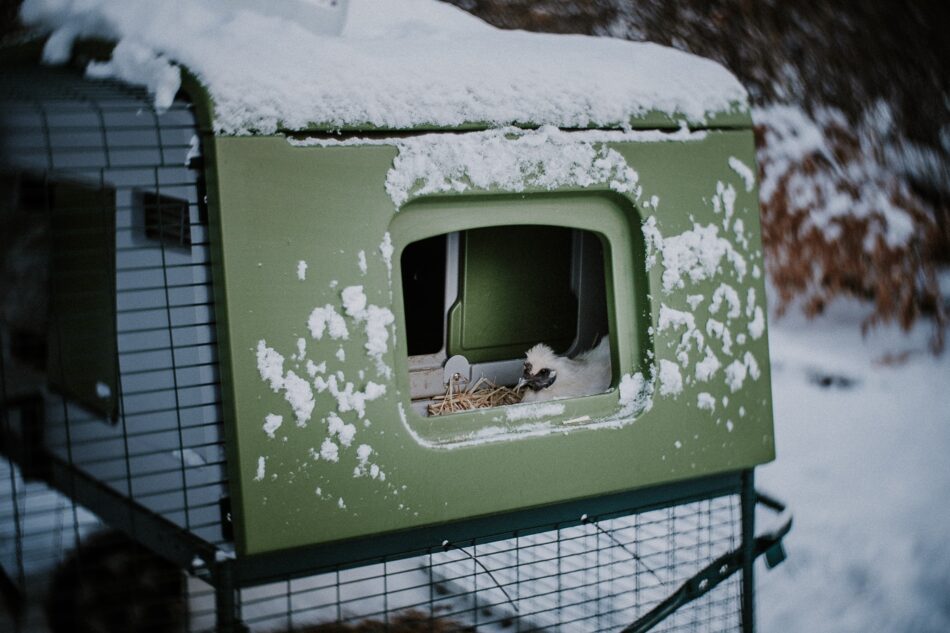
This entry was posted in Chickens

Did you know that you can keep chickens in the city? It’s true – you can have your own slice of farm life right in your backyard. There are a few special considerations when caring for chickens in an urban setting, but with a solid strategy and quality flock essentials, you’ll be able to enjoy fresh eggs and the unique experience of owning chickens.
Regulations
Most states in the US don’t have laws that apply to chicken keeping. However, individual towns, cities, counties, and homeowners associations (HOA) are responsible for sanctions regarding the ownership of chickens. Laws about keeping chickens are available to citizens of governing authorities. Contact your town or city’s zoning office to obtain the most recent rules and regulations for keeping chickens. If your home is subject to an HOA, be sure to contact the leaders to see if they have additional requirements or restrictions in addition to city ordinances. In places that allow chickens, most restrictions (if any) will likely apply to: roosters, number of chickens per backyard flock, and chicken coop placement or size.
Do you have enough time to raise chickens?
After you’ve gotten permission or verified there are no restrictions for having chickens in your backyard, it’s time to make a plan! First and foremost, you’ll need to evaluate how much time you have to dedicate to a backyard flock. Will you be home daily to collect eggs and check in on your chickens? Do you travel a lot? Would someone be willing to tend to your flock in your absence?
As far as pets go, chickens are relatively low-maintenance. Chickens don’t require daily interaction from their humans like other pets, but they do need basic provisions. If they have a secure chicken coop and run, their food can be left out and refilled as needed, along with their water. An easy-to-clean chicken coop is a huge time-saver when it comes to refreshing your hens’ home. Chicken coops in the city should be cleaned daily to minimize the presence of odors and insects.
Laying hens should have their eggs collected daily if possible to prevent attracting nest-thieving predators. When collecting eggs, take the time to do a brief check-in with your hens to make sure everyone is healthy and happy. Inspecting your hens’ eggs can also give you a good idea of their overall health.
You’ll need to have a reliable chicken-sitter for when you go out of town. Most people from the city would love the opportunity to care for chickens, but may be unfamiliar with hens. Provide detailed instructions and allow ample time for your chicken-sitter to come by and watch how you tend to your flock before leaving.
Consideration for neighbors
Once you’ve determined how and where you can house your hens, and decided that the time commitment fits with your lifestyle, it’s time to prepare your backyard for your flock. Do you want a mobile chicken coop that can be repositioned, or the more permanent placement of a coop with a walk in run chicken run?
Keep in mind that while chickens themselves have little to no odor to the human nose, their droppings do. Be considerate when choosing the location of your chickens’ coop – toward both yourself and your neighbors. Daily coop cleanings will cut down on smells and the presence of flies, but you should place your hens’ house an appropriate distance from human dwellings.
Most hens won’t make much noise, but they can stir up a ruckus when something is amiss in their surroundings, or when they have laid an egg. The majority of chicken sounds and their meanings are quiet daily interactions with each other and their surroundings. However, some hens are capable of making noises that may come across as other-worldly to your neighbors, so it’s a good idea to explain your new backyard inhabitants to them ahead of time! And, even if you’re not restricted from owning roosters, be aware that they crow at all hours – not just at dawn. In fact, many roosters will crow in the middle of the night. If you’re in close proximity to neighboring houses, it’s best to forgo owning a rooster.
Urban predators
Urban settings are not immune to the presence of predators that have a taste for chickens. While most backyards in the city won’t experience larger predator attacks, there are still several animals that may try to infiltrate your chickens’ coop or run. Urban predators include:
- Rats
- Snakes
- Raccoons
- Hawks
- Opossums
- Neighborhood cats or dogs
The Eglu Cube Chicken Coop is a predator-resistant option for backyard flock keepers. The unique coop door mechanism makes it difficult for animals to pry open during the night, and the locking egg access and rear doors help keep unwanted visitors out.
An Omlet Walk In Chicken Run provides safety measures from the ground up. Anti-dig skirting comes standard on all Omlet chicken runs to help prevent tunneling in from the outside, and mesh roof panels keep aerial predators at bay.
If your space doesn’t allow for a walk in run, an automatic chicken coop door can be installed on your Eglu Cube or other chicken coop to ensure your hens are tucked away safely each night. Not only can you automate your chickens’ schedule with the Autodoor, but you can add an additional layer of security between your flock and potential threats. The Autodoor opens horizontally on a spiraling metal mechanism, making it extremely difficult for animals to pry open.
Noise of the city
Your chickens may be temporarily upset by the noises created by traffic or pedestrians. Since chickens are adaptable, they’ll grow accustomed to the noise over time, but if possible position your chickens’ coop behind a good sound barrier. This could be your home, a privacy fence, or another solid structure.
If you’re introducing farm-raised hens to an urban setting, the transition may be more stressful than chicks raised in your environment. Consider placing chicken run covers on the sides of your flock’s run to give them a reprieve from visual stimulation while they process the noises of their new surroundings.
How Omlet can support city chicken keeping
Chickens are happy just about anywhere, but at Omlet, we want them to be able to foster their natural behaviors no matter where they live. All of our chicken products are designed to enrich your flock’s environment – no matter how big or small. Chicken peck toys, the Freestanding Chicken Perch and Chicken Swing are just some of the products we’ve invented to keep your hens healthy and happy in their home. With a chicken coop and run to fit any size backyard, you’ll find that our expertly designed products will ensure success when keeping chickens in the city.
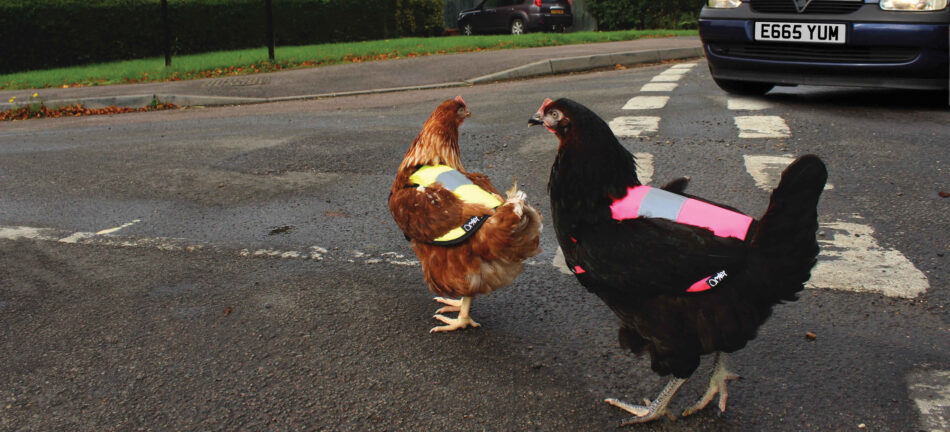
This entry was posted in Chickens

Protecting your chickens from raccoons may not be your first thought when preparing for predators. However, they pose a real threat to chickens. Raccoons may appear cute, but they’re also crafty. These masked mischief-makers are notorious for infiltrating chicken coops not only in search of food, but for eggs – and even your hens.
Raccoons have five fingers, but lack an opposable thumb. Despite this, they have extremely sensitive hands. Combining this dexterity with deftness, raccoons can unlatch, untie, and unscrew safety and locking mechanisms. This makes wooden chicken coops particularly vulnerable to raccoon invasions. Predator-resistant chicken coops are essential to outwit raccoons and keep your flock safe.
Where are raccoons found in the US?
Raccoons can be found in nearly every US state, with the exception of small portions of the Rocky Mountains, and southwestern states such as Nevada, Utah, and Arizona. The territory of this chicken predator also spans into Mexico and South America, all the way up into Canada. There are 7 different species of raccoons, but the most common is the North American raccoon. They’re members of the procyonidae family, and cousins to coatis, kinkajous, and ringtails.
Traditionally, raccoons make their homes in hollows of tree trunks or burrows, but throughout the years they’ve adapted to live in a variety of habitats. Raccoons now thrive in urban settings by taking up residence in attics, chimneys, and underneath houses or porches. In more rural settings, they will make their homes in barns, outbuildings, wood piles, or other opportune shelter options.
Why raccoons are a danger to your flock
Primarily nocturnal mammals, raccoons are most active at night. They’re incredibly crafty, capable of problem solving and can remember solutions to problems for up to 3 years. That means once they’ve learned how to break into your chicken coop, they’ll remember how they did it for years to come!
Signs of a raccoon attack
Crafty as they may be, raccoons often leave evidence of their presence. Their footprints are very distinctive: 5-toed, slender, with an almost human-palm shape. Their droppings can also be very telling. Most raccoons incorporate lots of seeds, nuts, or berries into their diet, which are usually expelled resembling how they were ingested. Clumpy or nodule shaped droppings with noticeable seeds, nuts or berries is usually indicative of raccoons.
Damage to your chickens’ enclosure may also be evident. Look for claw marks (particularly around gates or latches), gnawed material, or stretched wire. Raccoons will often reach for their prey, so chicken wire may appear bent, stretched, or even broken at the welds.
Check other areas around your home such as garbage cans, outdoor pet areas, or wild bird feeders for the signs of raccoons being present. Some chicken keepers place trail cameras or motion activated security cameras around their flock’s enclosure to monitor for predators, and to confirm what type of predator paid their coop a visit.
Do raccoons eat chickens?
Raccoons most certainly eat chickens. Their diet is similar to that of other wild omnivores such as coyotes, bears, or foxes, all of which are associated with preying on chickens. Raccoons can easily take down small breed hens, and if hungry enough, will make an attempt at standard or large breed hens.
While this small predator might not be the first that comes to mind when preparing your chickens’ area for attempts by predators, raccoons shouldn’t be overlooked. They’re more abundant and adaptable than many other chicken predators, and are patient and calculating when looking for a meal.
Predator-resistant chicken coops
The Eglu Cube Chicken Coop offers maximum security for your flock. The Eglu Cube has innovative coop access door t-locks that must be pressed down and twisted in order to unlock. It’s easily opened by older children and adults, but the lack of opposable thumbs makes breaking into the coop very difficult for raccoons. New for spring 2023, the Cube’s attached run also features a tighter mesh along the lower panels. The bottom 20 inches of the attached run will keep your hens safe from raccoon reaches. These features, along with its elevated and sturdy design, make the Eglu Cube the ideal hen house chicken coop to protect your flock.
Pair the Eglu Cube with an Omlet Walk In Chicken Run with anti-tunnel skirting, and your chickens will have predator-resistant measures in place both day and night. The heavy-duty wire of the walk in run extends from the skirting all the way across the sides and top for complete coverage. And, with stable-style doors with predator-resistant locks on the walk in run rather than simple latches, raccoons will be baffled.
6 tips to protect your flock from raccoons
The following actions will help make your chickens’ area less inviting to racoons. Many of these can be accomplished in a day, making sure your chickens are prepared by the following night.
Ensure your chickens’ space is clean
Raccoons have excellent olfactory senses, and are drawn to anything that smells like a meal. Chicken feed, scratch and treats are very tantalizing to a raccoon. If you notice recurring raccoon visits, feed your chickens at specific times and pick up any uneaten food. Scratch can be served in Chicken Peck Toys, and fresh fruits and veggies in a Caddi Chicken Treat Holder to cut down on waste.
Clean your chickens’ coop regularly to cut down on scents. Chickens themselves aren’t odorous, but their droppings are. An easy-to-clean chicken coop that can be pressure washed and disinfected will reduce odors that will attract raccoons and other predators.
Make sure garbage and pet food is secured and out of reach
Raccoons are opportunistic omnivores, and will feast on just about anything they can get their paws on. They’re especially fond of the buffet that your garbage has to offer! To keep from attracting raccoons, be sure that all trash is tied up in garage bags and kept in a bin with a lid. If your trash cans don’t have a tight seal, you may need to bungee lids down or fit them with a locking mechanism to keep raccoons out.
Food for outdoor pets is also appetizing for raccoons. Be sure to keep pet food in air-tight containers and pick up any uneaten food at the end of the day. Keep bird feeders out of reach of raccoons to prevent that temptation as well!
Collect eggs regularly
Eggs are a favorite snack among humans and omnivorous animals alike – and raccoons are no exception. It’s always best to remove eggs from the nesting box daily, even though chicken eggs can stay in the coop and still be edible for an extended period of time. By removing eggs before nightfall, you’ll prevent them from becoming a raccoon’s midnight snack.
Use an Autodoor to ensure chickens are safely tucked in at night
To keep your chickens safe from raccoons, it’s vital that they are locked in their coop overnight. Since raccoons are nocturnal, they do the majority of their hunting under the cover of nightfall. A chicken coop with a strong, predator-resistant latching mechanism on its door is your flock’s best nighttime defense.
The Omlet Automatic Chicken Coop Door adds an additional layer of safety through its unique horizontal closure on metal gears. Raccoons can lift traditional pulley style vertical chicken coop doors, but the Autodoor closes on a screw-style mechanism without gaps along the side for predators to get their claws into. Best of all, the Autodoor can be programmed to close at specific times based on the amount of daylight or a time that you set. That way, your chickens get tucked in safely each night – whether or not you’re home to oversee flock curfew.
Closing your chicken coop’s door overnight is one of the best practices to help keep your hens safe from predators of all varieties. Most animals that seek out chickens (like raccoons), are nocturnal. For your peace of mind and your chickens’ safety, your flock should be closed inside their coop shortly after dusk.
Using scents to repel raccoons
Since raccoons have a sophisticated sense of smell, some scents may cause them to turn their nose up. There are multiple DIY natural raccoon repellent mixtures you can try, but common ingredients that are offensive odors to raccoons include:
- Cinnamon
- Black pepper
- Cayenne pepper
- Onion
- Peppermint
- Epsom salt
Deterring raccoons with scents is only a temporary solution, and requires frequent reapplications. You should also use caution when spraying anything around your flock, as these ingredients can also irritate their respiratory system. Spray a wide perimeter around your chickens’ run and coop to avoid making your hens ill.
Hardware cloth
Hardware cloth may be used to surround existing chicken coops and runs, but its effectiveness is dependent on the integrity of the structure. Raccoons are very persistent and will pry mesh loose if they are able to. Any wood that hardware cloth is attached to should be solid enough to hold staples or fencing nails firmly in place. You’ll also need to run hardware cloth down the sides of your chicken coop turned at a 90° angle to act as anti-tunneling protection.
The anti-tunnel skirting on Omlet chicken runs helps prevent persistent predators from digging in. Additional security can be added along the bottom panels of the run in the form of hardware cloth to help keep prying paws from reaching through to your chickens. Nylon ties can be used to affix the cloth to the wire of the walk in run.
How Omlet can support city chicken keeping
Omlet has taken predators, including raccoons, into account when designing our chicken products. We’ve taken great care to create and research methods to protect chickens against predators, allowing you to enjoy a stress-free chicken-keeping experience. Sleep in peace knowing that your hens are safe in a chicken tractor at night, and that you’ve done your due diligence to keep your flock safe from raccoons.
This entry was posted in Chickens







































